
12
20
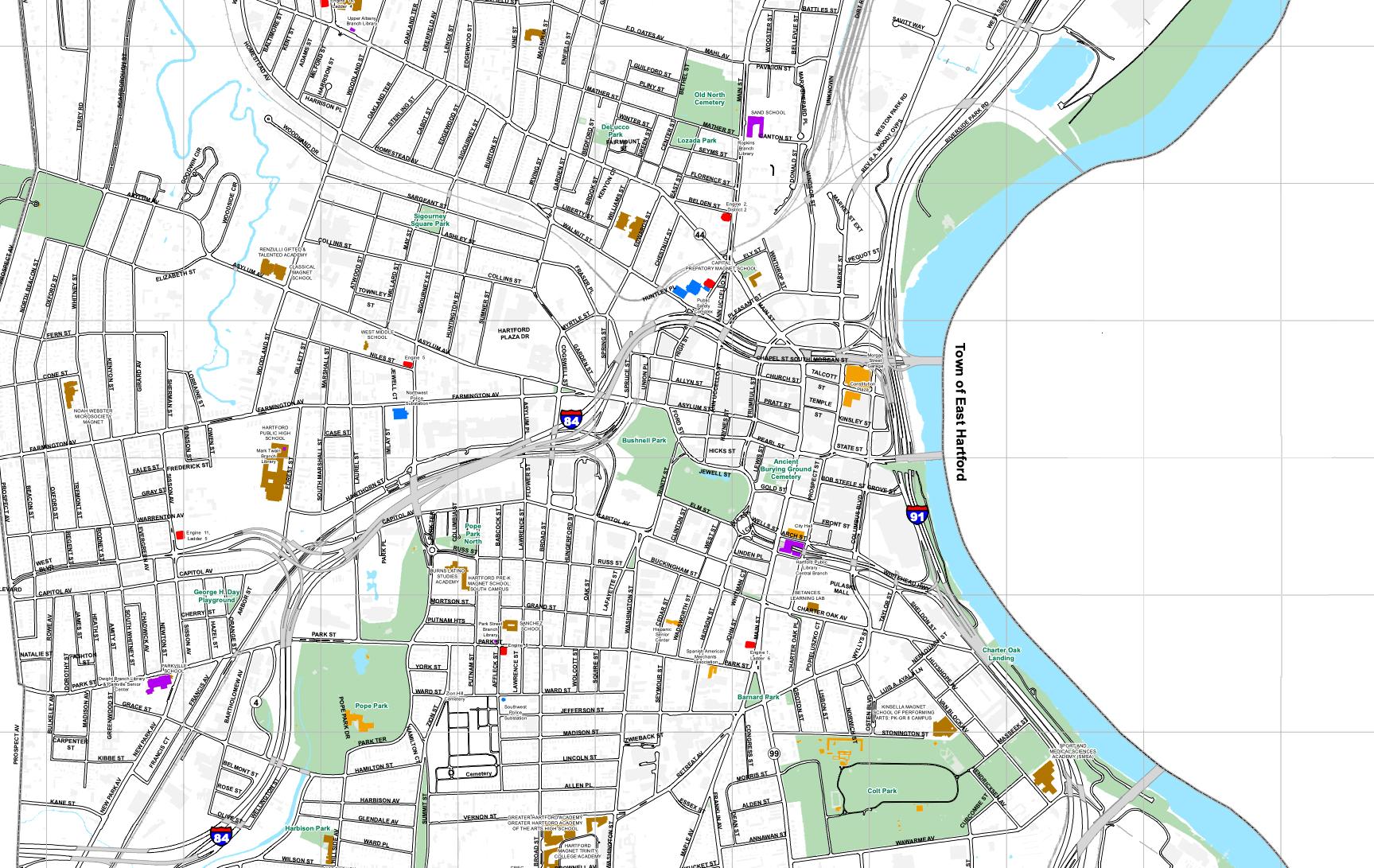

1.
2.
3.
5.
10.
11.
12.
20.
21.
22.
23.
24.
25.
26.
2 3
Edgemaster Barbershop
Hair Heaven
8.
9.
Harrison’s House of Styles
Headline-Hair Designers
Hombre a Place of Our Own barbershop
Red Carpet Barber Salon
Sebastian and Company Salon
Significant Hair Boutique
Timz Healthy Hair
Tropical Barbershop
Yamari’s Unisex Salon
Wise Guys Scissor Society
Bella Forever
Brown Skin Women Studio
Brothers Barbershop
BSW Hair
4.
Constitution Plaza Barbershop
Capellán Barbershop
Dominican Beauty Bar Barbershops & Salons of downtown Hartford
. Brown Skin Woman
. Headline-Hair Designers
. Capellán Barbershop
. Dominican Beauty Bar
. Mia’s Hair Beauty
. Harrison’s House of Style 8. Edgemaster Barbershop
. Professional Barbershop Since 1927
. Sebastian and Co. Salon Company Salon
. Significant Hair Boutique
. Wise Guys Scissor 23. Timz Healthy Hair 24. Tropical Barbershop
. Perfect Look Hair Design
. The Prime Stylez
6.
7.
2
11
6
7
14
10
18
21
22
26
17
19
. Red Carpet Barber Salon BrothersBarbershop
. Hair Heaven
. Yamari’s Unisex Salon
. Constitution Plaza Barbershop 15. Nu Style Cut Creators
. Michelle Unisex Salon
. Bellas Forever
9
25
5
13
1
. Hombre a Place of Our Own barbershop
. BrothersBarbershop
.Oggi Salon & Spa
Mile Radius
Michelle’s Unisex Salon 14. Mia’s Hair Beauty Supply 15. Nu Style Cut Creators 16. Oggi Salon & Spa 17. Perfect Look Hair Design 18. Professional Barber Shop Since 1927 19. The Prime Stylez
3
16
1
13.


4 5 Introduction / Introducción Facts about hair .............................................. 15 The CROWN Act .............................................. 16 Ashley Innocent ................................................19 Mango Ripe Sol Grapefully Her Sandra del Bonis ............................................. 22 On Becoming Acquisition Mistaken Identity Michael Madore ............................................... 24 On a Lark Hamid Hemat ................................................... 25 Hair in Persian Literature Sasha Ovelle Fay ............................................ 28 The Forgotten Lisa Pressamarita .......................................... 30 Harry Bates ..................................................... 31 Power and Pride Stephanie Okormea Nyarko .......................... 32 Scalp and All Series, Untitled 13 Scalp and All Series, Untitled 1 Scalp and All Series, Untitled 4 Tender Headed Bettina Byrd-Giles .......................................... 34 Our Hair Ande’Ja Johnson and third grade students ....................................... 35 Chloe Collins ................................................... 36 A Photo from the Auerbach Art Library Max Holsbeke .................................................. 38 Untitled Jadyn DeWitt-Smith ...................................... 39 Salon Hendrick Xiong-Calmes ................................. 41 Things I Imagined Carol Cheney My White Hair and Science ..................... 42 Linda Roth ....................................................... 44 Silvana de la Osa ............................................ 45 Rat’s Nest Hair/Ties Cabello/Vínculos Hair/Cut Cabello/Corte CONTENTS
6 7 Aubrey Horn .................................................... 48 Dye-A-Gram #1 Dye-A-Gram #2 Ruth P. Clark .................................................... 50 Philippe Halbert .............................................. 52 Allison Goldie .................................................. 53 Aging Erik Bowen ....................................................... 54 Susan Bass ....................................................... 55 Ned Lazaro ...................................................... 56 Object Snippet: Vicomtesse Simon de Vaulchier by Margaret Foote Hawley Chloe Collins ................................................... 58 Loc Journey Timeline Adrian Martinez Chavez ................................. 61 Untitled, 2016 Untitled (Marco), 2020 Untitled (Corte de Pelo), 2020 Rosanne Daigneault ....................................... 64 Carol’s Salon of Beauty Paulina Yi ......................................................... 65 Untitled Jama Holchin ................................................... 66 Natalia German ............................................... 67 Flowers Annmarie Gioscio ........................................... 68 Impulsive Bangs Jasmyne Pinkey .............................................. 69 Meg Smith .........................................................70 From the Root (Hair Follicles) Brigitte Reyes .................................................. 71 Curly Confidence Alphonso McGriff III ....................................... 72 Haircuts by Alphonso Lucy Li ...............................................................73 3 Facts About My Hair Zen Hansen ...................................................... 80 Excerpt from The Hair Anthropology Guide to Hair Collection Hair/Care Cabello/Cuidado CONTENTS Beth Malley.........................................................82 Good Luck Girl Overwhelmed Busy Girl Francine Austin ................................................84 Nahndi Ali ........................................................ 86 Zifan Wei ......................................................... 87 Untitled Katherine Zhong ............................................ 89 Tangled Jadyn DeWitt-Smith ...................................... 90 Tender-Headed Crown Katie Bennet ................................................... 92 Boy Cut Christi Moraga ................................................ 94 Reflections on Venomous Coiffures Najja Elon Lawson .......................................... 96 The Trumpet Nadia Sims The L.O.C. Method .................................... 97 Sigi Ge ............................................................. 98 Nephele Richard Kirby .................................................. 99 Keri Halloran ................................................. 100 Clipped Hair Hair Static Isabella Kossivi ............................................. 102 Artwork Reflection Liz Calvi ......................................................... 103 Excerpts from Miss World Carmen Veal Conway ................................... 108 Hair Texture: Unveiling the Unique Tale of Your Tresses Vanessa Sigalas ............................................ 109 Vanessa’s Ten Facts About Hair Quiz ................................................................. 112 Is Your Hairstyle Doing You Any Favors? Hair crossword puzzle .................................. 113 CONTENTS Hair/Tangles Cabello/Enredos
Everyone has a hair story to tell.
Hair is an integral part of us. It is personal and intimate while also being one of the most visible ways we express our identity to the world. We use it to reinvent or disguise ourselves. We style our hair to make a statement: to follow trends and conform, or to forge our own path in defiance of social norms. But hair is more than symbolic—it is a tangible manifestation of our DNA, tying us to our ancestors. We keep hair as a token of love and remembrance, honoring a child’s first haircut or a loved one who has passed. Its significance on both a personal and societal level has made hair a powerful focus of art throughout human history.
The works in the Styling Identities: Hair’s Tangled Histories exhibition are primarily drawn from the Wadsworth Atheneum’s own collection of over 50,000 objects. Supplemented with key loans from The Amistad Center for Art & Culture, the Connecticut Museum for Culture and History, and other partners, this exhibition is wide-ranging but not comprehensive. Historically, our collecting practices were shaped by views in the art world that centered white, male, North American and European artists. Today we have a broader perspective, but we cannot change the past. We do not have works that directly speak to every hair experience. Our focus is telling stories about what hair means to us—as individuals, as a museum, and as a community. We hope the exhibition prompts you to think about your own relationship to hair and to discover shared strands through the diverse objects and stories reflecting different life experiences.
How do these objects speak to your hair story? How do they reflect ours? This exhibition is as much about us as it is about hair.
— Bethani Blake, Emma Cameron, Chloe Collins, Harmony Cooper, Denise Giannino, Mark Giuliano, Matthew Hargraves, Hamid Hemat, Jama Holchin, Alexisjacqueline Martinez, Michelle McFarland, and Vanessa Sigalas
Styling Identities: Hair’s Tangled Histories was curated by a team of staff across departments at the Wadsworth Atheneum Museum of Art and The Amistad Center for Art & Culture, in partnership with a Community Advisory Board including Jasmin Agosto, Marian Andoh-Clarke, Harry Bates, Carmen Veal Conway, Miguel DelValle, Miriam Gopin, Christina Jackson, Dalia Kulek, Rabbi Yosef Kulek, Prabhjit Mutneja, Andre Rochester, Graciela Rivera, Husna Sayeed, Gurmeet Singh, and Karen Taylor. We gratefully acknowledge their immense contributions in bringing this project to fruition. In addition, we thank Janice Castle, Ann Marie Drury, Aubrey Horn, and Joe Bun Keo for their assistance in developing the exhibition. We also extend our deepest gratitude to Revisionist Films, Amaranta’s Hair Salon, Brown Skin Women Studio, INDAKUT Barbershop, and all the individuals who agreed to take part in our video projects, as well as everyone who shared their hair story through the Zine, a reflective label, or the mobile guide.
This exhibition is better because of you.
Styling Identities: Hair’s Tangled Histories is made possible through the generous support of
Identidades de Estilo: Historias Enredadas del Cabello es posible gracias al generoso apoyo de





8 9
Styling Identities
Todos tenemos una historia de cabello que contar.
El cabello es una parte integral de nosotros. Es personal e íntimo y al mismo tiempo es una de las formas más visibles en que expresamos nuestra identidad al mundo. Lo usamos para reinventarnos o disfrazarnos. Nos peinamos para hacer una declaración: para seguir tendencias y adaptarnos, o para forjar nuestro propio camino desafiando las normas sociales. Pero el cabello es más que simbólico: es una manifestación tangible de nuestro ADN que nos une a nuestros ancestros. Mantenemos el cabello como muestra de amor y recuerdo, en honor al primer corte de pelo de un niño o a un ser querido que falleció. Su importancia tanto a nivel personal como social ha hecho del cabello un enfoque poderoso del arte a lo largo de la historia de la humanidad.
Las obras de esta exposición provienen principalmente de nuestra propia colección de más de 50,000 objetos. Complementada con objetos prestados clave del The Amistad Center for Art & Culture, the Connecticut Museum for Culture and History y otros socios, esta exposición es amplia pero no exhaustiva. Históricamente, nuestras prácticas de coleccionismo estuvieron determinadas por visiones del mundo del arte que se centraban en artistas blancos, masculinos, norteamericanos y europeos. Hoy tenemos una perspectiva más amplia, pero no podemos cambiar el pasado. No tenemos trabajos que hablen directamente de cada experiencia de cabello. Nuestro objetivo es contar historias sobre lo que significa el cabello para nosotros—como individuos, como museo y como comunidad. Esperamos que la exposición te impulse a pensar en tu propia relación con el cabello y a descubrir hebras compartidas a través de diversos objetos e historias que reflejan diferentes experiencias de vida.
¿Cómo hablan estos objetos de la historia de tu cabello?
¿Cómo reflejan los nuestros? Esta exposición trata tanto de nosotros como del cabello.
— Bethani Blake, Emma Cameron, Chloe Collins, Harmony Cooper, Denise Giannino, Mark Giuliano, Matthew Hargraves, Hamid Hemat, Jama Holchin, Alexisjacqueline Martinez, Michelle McFarland y Vanessa Sigalas.
Identidades de Estilo: Historias Enredadas del Cabello fue curado por un equipo de personal de todos los departamentos del Museo de Arte Wadsworth Atheneum y el Centro Amistad para Arte y Cultura, en asociación con una Junta Asesora Comunitaria que incluye a Jasmin Agosto, Marian Andoh-Clarke, Harry Bates, Carmen Veal Conway, Miguel DelValle, Miriam Gopin, Christina Jackson, Dalia Kulek, el rabino Yosef Kulek, Prabhjit Mutneja, Andre Rochester, Graciela Rivera, Husna Sayeed, Gurmeet Singh y Karen Taylor. Reconocemos con gratitud sus inmensas contribuciones para hacer realidad este proyecto. Además, agradecemos a Janice Castle, Ann Marie Drury, Aubrey Horn y Joe Bun Keo por su ayuda en el desarrollo de la exposición. También extendemos nuestro más profundo agradecimiento a Revisionist Films, Amaranta’s Hair Salon, Brown Skin Women Studio, INDAKUT Barbershop y a todas las personas que aceptaron participar en nuestros proyectos de video, así como a todos los que compartieron su historia de cabello a través de Zine, una etiqueta de reflexión, o la guía móvil. Esta exposición es mejor gracias a ti.
10 11
Styling Identities
Introducción al “zine”
A note about the zine
Collaboration has been central to the planning of Styling Identities: Hair’s Tangled Histories from the beginning stages. It was important for the exhibition catalog to reflect the unique way this exhibition was planned by a wide range of staff in partnership with members of the community. Few aspects of this exhibition were done conventionally, so it only seemed right for us to create a publication different from a typical exhibition catalog.
We chose to create a zine because they are independently published, and their content often takes on a more specialized or personalized focus than other publications. This zine contains contributions from the Styling Identities curatorial team, other museum staff, and community members of all ages and backgrounds. Submissions include paintings, photography, collages, poems, and personal reflections.
One’s relationship with hair is personal, and there are as many stories to tell as there are people. Thank you to all of the contributors who shared their stories and to everyone who made this zine possible.

Chloe Collins, co-curadora de Identidades de Estilo y gerente editora del Zine
La colaboración ha sido fundamental para la planificación de Identidades de Estilo: Historias Enredadas del Cabello desde las etapas iniciales. Era importante que el catálogo de la exposición reflejara las formas únicas en que esta exposición fue planificada por una amplia gama de personal y en asociación con miembros de la comunidad. Muy pocos aspectos de esta exposición se hicieron de manera convencional, por lo que nos pareció correcto crear una publicación diferente a un catálogo de exposición típico.
Elegimos crear una revista porque se publican de forma independiente y su contenido a menudo adquiere un enfoque más específico o personalizado que otras publicaciones. Esta revista incluye contribuciones del equipo curatorial de Identidades de Estilo, otro personal del museo y miembros de la comunidad. Las presentaciones incluyen pinturas, fotografías, collages, poemas y reflexiones personales.
La relación que uno tiene con el cabello es personal y hay tantas historias que contar como personas. Esta publicación fue creada por la comunidad para la comunidad. Gracias a todos los contribuyentes que compartieron sus historias.

12 13
Chloe Collins, Styling Identities co-curator and managing editor of the Zine
Styling Identities

Facts About Hair
• Hair is primarily composed of a protein called keratin, which is also found in the outer layer of the skin and in nails.
• The average rate of hair growth is about half an inch (1.25 centimeters) per month. This can vary among individuals and is influenced by genetics, age, and overall health.
• Hair color is determined by the presence and concentration of a pigment called melanin. There are two main types of melanin: eumelanin, which is responsible for black and brown hair, and pheomelanin, which gives rise to red and blonde hair.
• Hair texture is largely determined by the shape of the hair follicle (for more information about hair texture see “Hair Texture: Unveiling the Unique Tale of Your Tresses” by Carmen Veal Conway p. 108.
• Hair goes through a continuous growth cycle with three phases: anagen (growth phase), catagen (transitional phase), and telogen (resting phase). Each hair follicle operates independently, which is why not all hair on your head is in the same phase at the same time.

• On average, individuals lose about 50 to 100 hairs from their scalp each day. Hair loss can be influenced by various factors, including genetics, age, hormones, and medical conditions.
15
Vanessa Sigalas, Styling Identities curator
Identities
Nataliia Darmoroz / Alamy Stock Vector Styling
Bethani Blake, Styling Identities co-curator and The Amistad Center for Art & Culture liaison
Carmen Veal Conway, owner Brown Skin Women Studio & Styling Identities advisory board member
The CROWN Act. What is the CROWN Act?
The CROWN Act was established to combat discrimination against Black individuals based on their hair. Despite progress, discrimination, microaggressions, and unfair judgments against natural Black hair persist. This legislation plays a crucial role in safeguarding the rights and appearance of Black people across 21 states in their workplaces and educational institutions.
Creating a Respectfaul and Open World for Natural hair
Excerpts from the 2023 CROWN Workplace Research Study
Bias against natural hair and protective hairstyles can impact how Black women navigate the hiring process.
• Two out of three Black women change their hair for job interviews. Among them, 41% augment their natural, curly texture to straight.
• Black women with coiled or textured hair are two times as likely to experience microaggressions in the workplace than Black women with straighter hair.
• Black women’s hair is 2½ times more likely to be perceived as unprofessional.
• Black women are 54% more likely to feel they must wear their hair straight to a job interview to be successful.
• Over 20% of Black women ages 25 to 34 have been sent home from work because of their hair.
Excerpts from the 2021 Dove CROWN Study for Girls
• Hair discrimination is happening early and continues as a woman gets older.
• 47% of Black mothers report having experienced discrimination related to their hair.
• 86% of Black teens who experience discrimination state that they have experienced discrimination based on their hair by the age of 12.
• 100% of Black elementary school girls in majority-white schools who report experiencing hair discrimination state that they experienced the discrimination by the age of 10.
• 66% of Black girls in majority-white schools report experiencing hair discrimination, compared to 45% of Black girls in all school environments.
• While 90% of Black girls believe their hair is beautiful, the microaggressions and discrimination they endure has an impact on how they see themselves.
• 53% of Black mothers whose daughters have experienced hair discrimination say their daughters experienced the discrimination as early as 5 years old.
• Trauma from these experiences causes girls to miss days from school; teenage Black girls are missing a week of school per year due to hair dissatisfaction.
Statistics pulled from www.thecrownact.com
16 17
Styling Identities
Hair/Ties
Is the way you wear your hair shaped by the communities to which you belong? Whether it’s a matter of faith, cultural heritage, or social connections, shared hairstyling techniques and hair accessories can help you celebrate and communicate who you are. The contributions in this section explore some of the ways people throughout time have used their hair to demonstrate belonging and community. However, not all communities are inclusive, and hair and hair styling can also be used to emphasize exclusivity, indicate class, and reinforce power hierarchies.
Cabello/Vínculos
¿La forma en que usas tu cabello está determinada por las comunidades a las que perteneces? Ya sea una cuestión de fe, herencia cultural o conexiones sociales, las técnicas de peinado y los accesorios para el cabello compartidos pueden ayudarte a celebrar y comunicar quién eres. Los contribución de esta sección exploran algunas de las formas en que las personas a lo largo del tiempo han usado su cabello para demostrar pertenencia y comunidad. Sin embargo, no todas las comunidades son inclusivas, y el cabello y el peinado también pueden usarse para enfatizar la exclusividad, indicar clase y reforzar las jerarquías de poder.
Ashley Innocent Mango

18 19
Styling Identities Hair/Ties
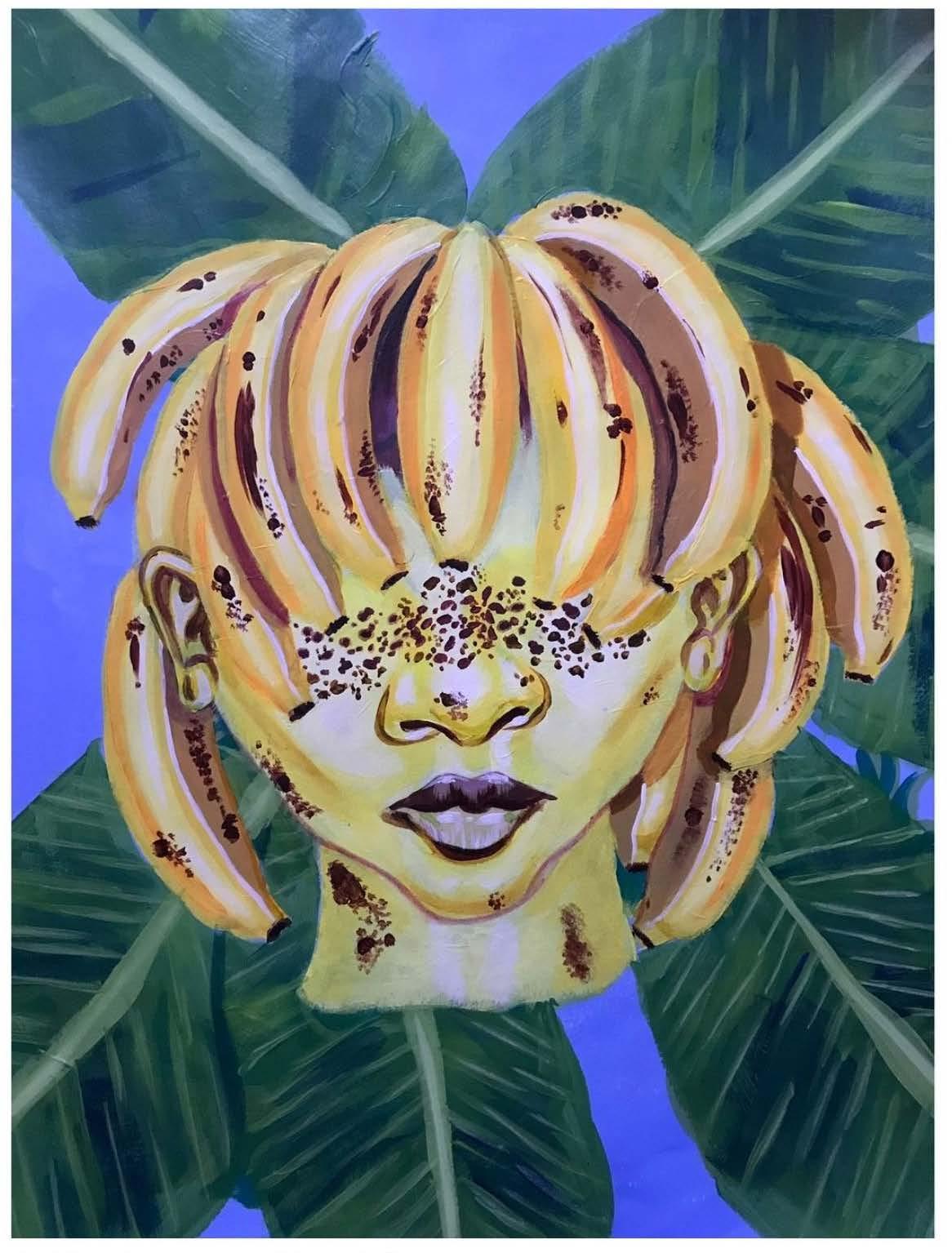
Grapefully Her

20 21
Ripe Sol
Styling Identities Hair/Ties
Sandra del Bonis
On Becoming
I have become my grandmother
Wearing braids in my waist-length hair
People ask if I am Indigenous And I explain
My grandmother came from Italy
A small village bombed by Americans while my uncle, her son, Fought as a US Marine and was executed In a Japanese prison camp
My ancient ancestors, I later learned,
Wore elaborate braids
As taught to me in A Greek and Roman Hair symposium
We take what we want
From our past
Sometimes not realizing Our needs
Acquisition
Her hair ramen noodles
Milky gray like the moon
Brushed with fog
Wrapping her identity
But not her eyes
Clear in color and intensity
Head held with attention
Listening to words
Trying them on like
A pair of lycra leggings
Transforming the body
And presenting itself as New
Mistaken Identity
“Storming the castle”
Shouted a couple
As I stood in the doorway
I did resemble that actress
My hair all akimbo.
22 23
Styling Identities Hair/Ties
Michael Madore
On a Lark
Hamid Hemat, Styling Identities co-curator
Hair in Persian Literature
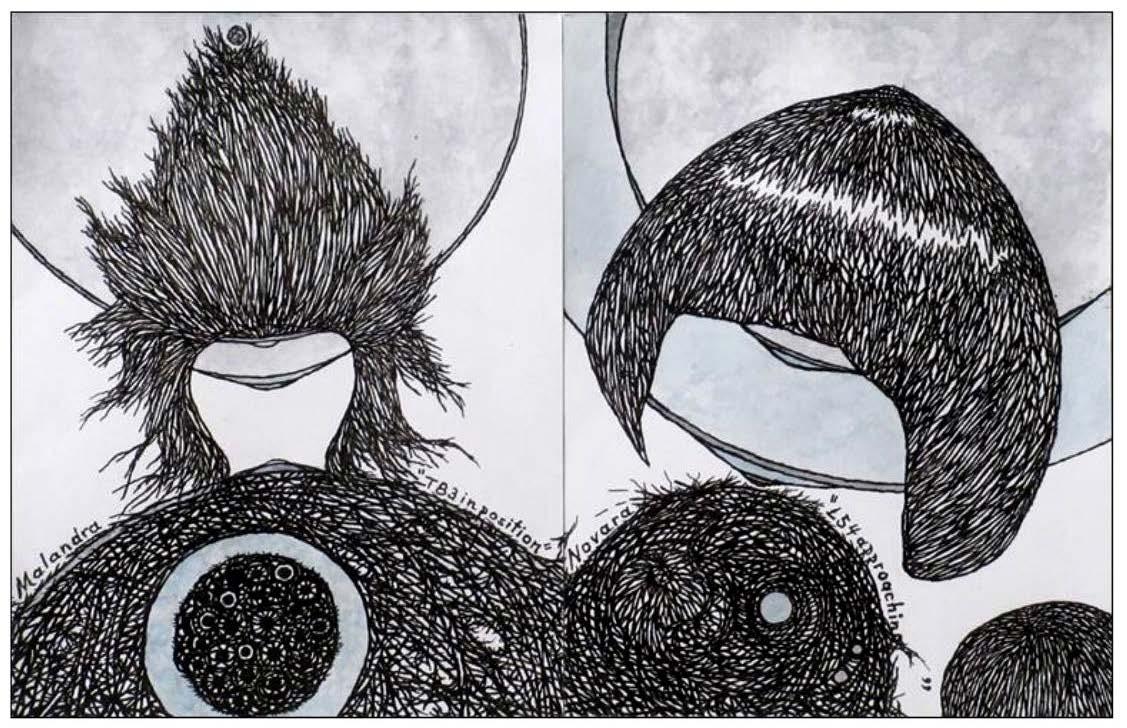
Long ago, in a Brenda Starr comic book there was a daringly vertical, rather elegant panel in which a wig was falling from a high-rise that made me think: What if wigs could fly? Sure it’s one thing to put one on and leave town under suspicious circumstances (and yes I have four sisters). But why not just leave the planet? On a lark?
Farsi literature has a special place for human hair; it is embedded in the sociocultural format of Persian communities and has a strong presence in poetry. Hardly a poet can be found who didn’t write poems in this realm. For poets, hair is a symbol of love and youthfulness when it is long and curly, and grief when it is tangled. Apart from that, the color of the hair has a special place too. Dark color imitates youth and energy, but white hair reflects a symbol of aging, burden, and separation. In Persian oral history, as long as a person is delighted and happy the hair stays black. Long, wavy, and curly hair is a symbol of beauty for women, and it was believed that if a girl combed her hair in the morning the wind would bring the scent to faraway places and attract the opposite gender. For men, hair is a symbol of power when it is dark and knowledge when it is white. In Afghanistan, as a mark of respect elders are called “Moy Safaid,’’ meaning a person having white hair—a sign of wisdom. Below are several selected poems regarding hair. They express how much it is connected to the cultures in Persian communities:
I wish she would not comb the hair tonight, After a long time I have peace of mind
Behrang Qasimi, contemporary poet

24 25
On a Lark, (2023; ink/pen/watercolor/paper; 17x11’’)
Styling Identities Hair/Ties
Whoever saw your curly hair, they never rest a moment
Fazil Nazari, contemporary poet
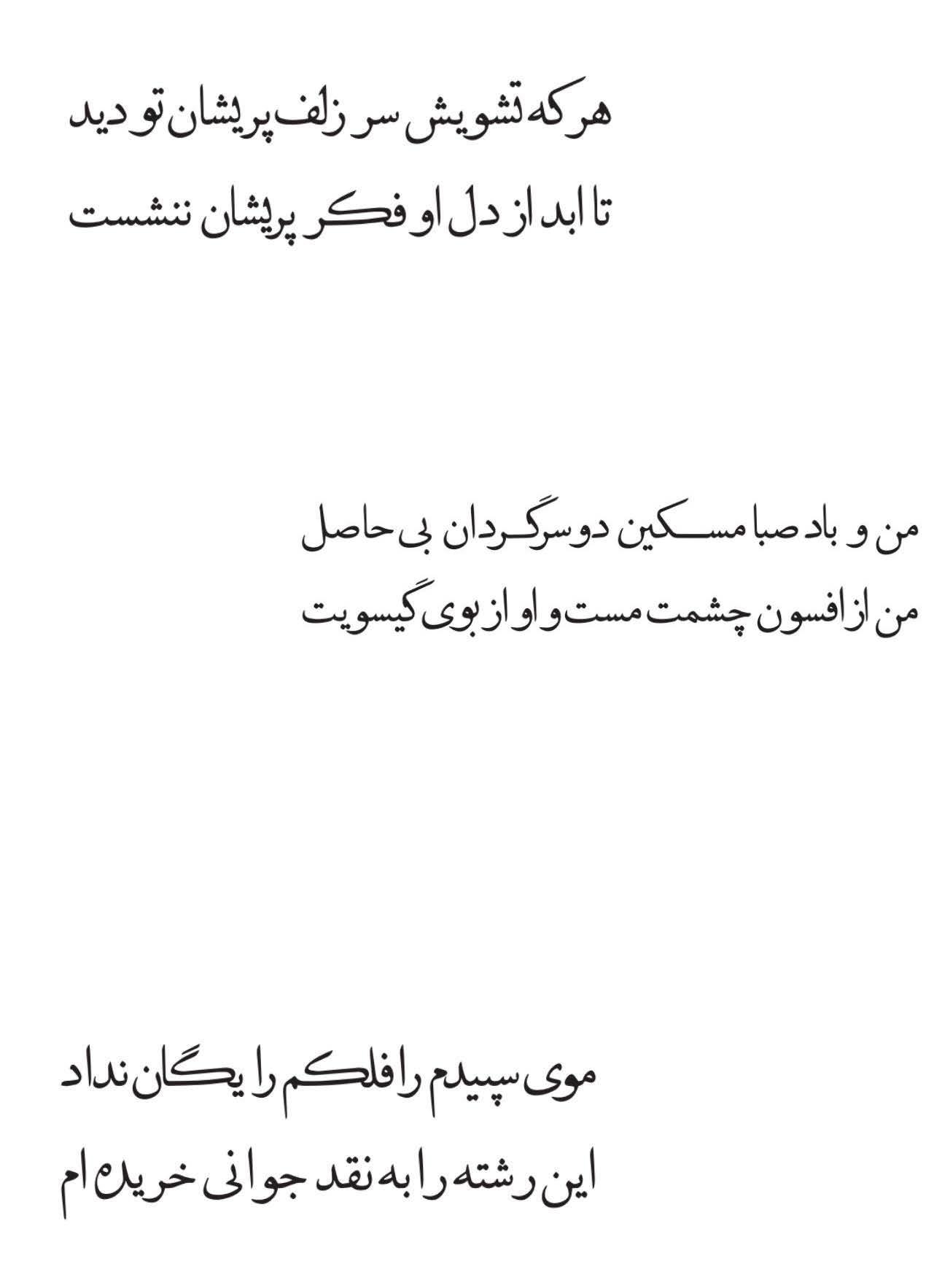
I and the morning breeze are both drunk, me from the charm of her eyes, and the morning breeze from her hair’s aroma
14th-century Hafiz Shirazi
The white hair was not given to me for free, I bought each thread with the price of my youth

Early 20th-century Rahi Moayeri
Oh wind, cover her face with her hair
Let only me be the person that has seen her face and stay distress
Early 13th-century poet Rumi
Oh, morning breeze, Bring the news from my beloved Tell me of her beauty
You will forget the entire garden’s aroma
If you attract with the scent of her hair
13th-century poet Saadi Shirazi
26 27
Styling Identities Hair/Ties
Sasha Ovelle Fay
The Forgotten



Scan to see behind the scenes video

28 29
Styling Identities Hair/Ties
Professional Barbershop 1927, Hartford, CT, has been styling men’s hair from finger waves with hair gel in 1927 to fades with pomades in 2023. Men’s hairstyles in art have been followed and set fashion trends down through the ages. This drawing of rock superstar Jon Bon Jovi was a gift to Lisa Pressamarita for her hair salon in West Hartford in 1985. A depiction in graphite on paper, and a popular ’80s rocker hairstyle. The artist is Mary Larsen of Bloomfield, CT.
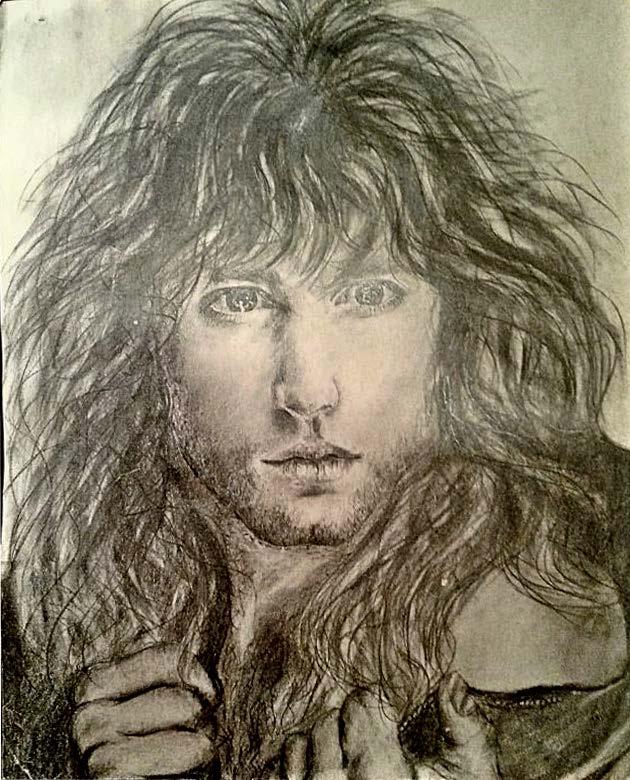
Power and Pride

30 31
Lisa Pressamarita
Harry Bates, owner of INDAKUT Barbershop and Styling Identities advisory board member
Styling Identities Hair/Ties
Stephanie Okormea Nyarko
Scalp and All Series, Untitled 13 2023
Altoid container, human hair, synthetic braiding hair, bobby pins 5’’x 5’’x 7’’
Scalp and All Series, Untitled 1 2022
Dudley’s container, human hair, synthetic afro hair, bobby pins 7’’x 7’’ x 4 inches
Scalp and All Series, Untitled 4 2022
Found object, synthetic afro hair, bobby pins 4’’x 4’’x 8’

Tender Headed 2023 vinyl leather, synthetic braiding hair, upholstery foam, quilt batting, wood 3 x 7 x 7 ft
Tender Headed detail
Tender Headed detail

32 33
Hair/Ties
Styling Identities
Bettina Byrd-Giles
Our Hair Tenderheaded. Move, get a pop on the back of the head with a comb.
Hair press. Scalp burn. Hot grease ear burn; steam; scald.
Good hair. Nappy hair.
Our hair.
Nappy headed. Beady bead. Hair that is this (snap your fingers) long.
Processed.
Crawling scalp. Pressed. Extensions. Heat. Dookie braids. Jump braids.
Big chop. Kitchen. Edges.
Bald. No hair. Straight hair.
Our hair.
Kinky. Curly. Cornrows. Afro puffs. Love knots. Top Knot.
Fingers. Flat iron. Straightening comb. Curlers. Rollers.
Pressed. Permed. Wigs. Doo rags.
Our hair.
Ande’Ja Johnson

The art piece that you see on this page was created by the third grade students of 2022 (Alexzander Akornortey, Armani Reed, Cattleya Phillips, Ethan Boetang, Faith Fraser, Gabrielle Boetang, Htee Moo Paw, Joshua Forsythe, Leonard Poe, Nathan Boetang, Ronald Taylor, Sibi Prakash, Noah Bush) under the guidance of their art teacher Ande’Ja Johnson for Trinity Academy’s annual cultural night (Dec 14th, 2022) in which students of each grade level (1st-4th) collaboratively create an art project based off of the particular culture they are learning about with their classmates.
This particular piece features a cardboard box base to create the shape of the continent of Africa, square pieces of white linen cloth drawn on with sharpie by individual students to create their own version of kente cloth, a premade fabric that features handprints. Spread through the canvas, you will find different mediums used to represent some of the natural resources found within the land of Africa such as coffee beans, gold, cotton and diamonds. In the background, behind the large display of the word “AFRICA” sculpted by braiding hair there are pieces of preserved green moss, brown sand and a river made by blue acrylic paint and hot glue gun marks to represent the landscape of Africa done by the teacher Ande’Ja Johnson.
34 35
Hair/Ties
Styling Identities
A Photo from the Auerbach Art Library

This photo, a Rudyard Kipling poem, and a nursery rhyme have more in common than one might assume. The photo was taken by the Greek photographers known as the Zangaki brothers in Egypt in the late 1800s and came to the Wadsworth’s Auerbach Art Library by way of the prominent Hartford undertaker W. R. Morgan. The photo shows a group of men who can be identified by their hairstyles as
The description on the photo appears to read “groupe des Bedouins/bicharins.” Both Bedouins and Beja are groups of nomadic peoples who live in Egypt as well as in other North and East African countries; Bedouin is likely a misnomer, since as far as I was able to find, Bedouins would not have worn this traditional Eritrean hairstyle called the tiffa. The term Bedouins may have also been used by the Zangaki brothers to describe Bicharins, who are a Beja subgroup, since they were both nomadic peoples.
Another subgroup of Beja people called the Hadendoa were known for wearing the tiffa as well. They fought against the British Empire and Egypt in the Mahdist War of the late 1800s and were given the nickname “Fuzzy-Wuzzy” by British soldiers, inspiring a poem of the same name by Rudyard Kipling. Hadendoa soldiers also fought in World War II, allying themselves with the British. The term “Fuzzywuzzy Angels” is also said to have been used by Australian soldiers to describe Papua New Guinean stretcher bearers in WWII who did not wear the tiffa hairstyle, but whose hair texture differed from the white Australians they rescued. Many people are familiar with this term thanks to the popular nursery rhyme, “fuzzy wuzzy was a bear...” or its use in reference to pets and children’s toys. It is still used in these contexts, though it’s now considered a pejorative way to refer to people with Afro-hair textures.
36 37
Photo of Beja men by the Zangaki Brothers. W. R. Morgan photo album, Photograph Collection, Auerbach Art Library, Wadsworth Atheneum Museum of Art, Hartford, CT.
members of the Beja ethnic group.
Chloe Collins, Styling Identities co-curator and managing editor of the Zine
Hair/Ties
Styling Identities
Max Holsbeke
Untitled
Jadyn DeWitt-Smith
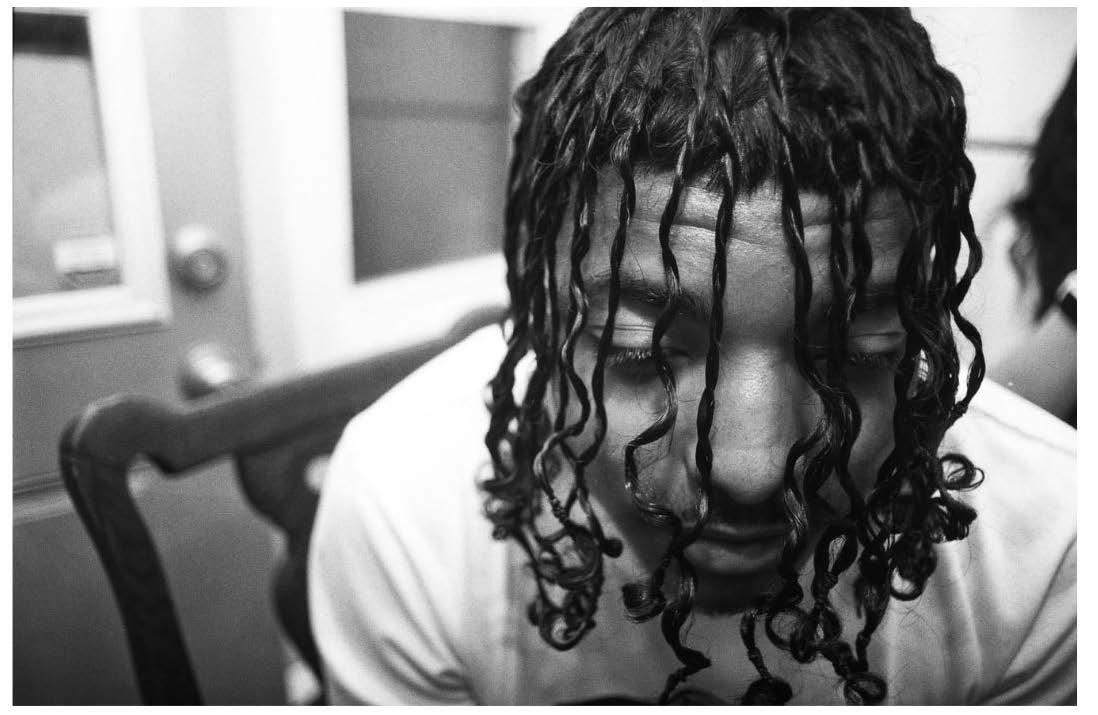

DeWitt-Smith’s work was created through The Amistad Center for Art & Culture’s SNAP! Photography artist residency—led by New Haven photographer, gallerist, and teaching artist, Kim Weston. This multi-week program engaged a variety of teens (grades 9-12) from in and around Hartford in portfolio creation, the business of fine arts, undergraduate program exploration, and the culmination of a group exhibition in the Wadsworth Atheneum Museum of Art’s Avery Court gallery titled, There is Always Something Left to Love curated by Bethani Blake.
38 39
Salon
Hair/Ties
2023, inkjet print
Styling Identities
Hair/Cut
Hair can be a marker of transition and change. Have you ever altered your hair to represent a big personal shift? Do you look at old pictures and use your changing hairstyles to bookmark different moments in your life? This notion that changing our hair in some way changes us is embedded in the very language we use about our hair—many of us have left the stylist’s chair saying, “I feel like a whole new person!” But beyond the individual, new trends in hair and hair styling can also reflect shifts in broader cultural values over time.
Cabello/Corte
El cabello puede ser un marcador de transición y cambio. ¿Alguna vez has alterado tu cabello para representar un gran cambio personal? ¿Miras fotografías antiguas y utilizas tus peinados cambiantes para marcar diferentes momentos de tu vida? Esta noción de que cambiar nuestro cabello de alguna manera nos cambia está relacionado con en el mismo lenguaje que usamos sobre nuestro cabello: muchos de nosotros hemos dejado la silla del estilista diciendo: “¡Me siento como una persona completamente nueva!” Pero más allá del individuo, las nuevas tendencias en cabello y peinado también pueden reflejar cambios en valores culturales más amplios a lo largo del tiempo.
Hendrick Xiong-Calmes
Things I Imagined

This piece seeks to explore my experiences with the spectrum of mental wellness and its relationship with my corporeality and appearance, especially with regard to my hair. I shaved my head in March 2020, and I have dyed my hair numerous colors, some of which are present in this piece. As a queer, second-generation Asian-American, so much of my identity has been formulated through my lived experience and found truths and I hope some of my story is conveyed through this piece.
The namesake for this piece comes from a song by Solange Knowles, “Things I Imagined.”
40 41
Hair/Cut
Styling Identities
Carol Cheney, Wadsworth Atheneum trustee
My White Hair and Science
My story begins way back, when white strands started appearing in my black hair while I was in high school. At first I plucked them out, but eventually I decided it was kind of cool when people commented on it and I could say I got scared by the boogeyman. By the time I was in my late 20s, my hair was mostly white. There was no gray, just white and diminishing black hairs. I pledged to myself I would never dye my hair to hide my “uncolor.”
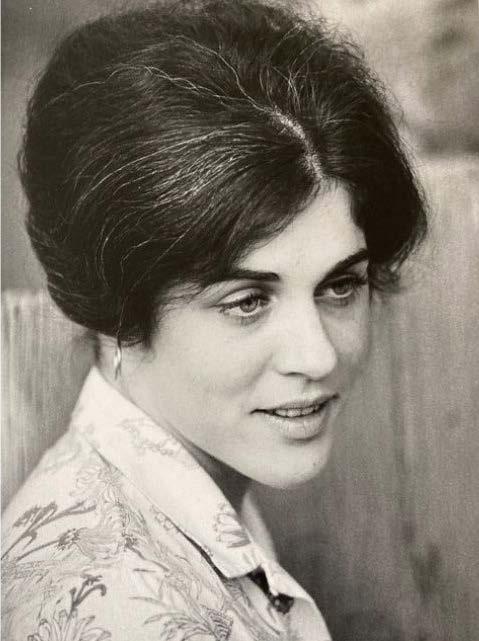 by Gary Gladstone
by Gary Gladstone
By then I had a young daughter and had just moved to Hamden across the street from a nice family I was just getting to know. One day the dad ran across the street and asked me if he could have samples of my hair. This was a really weird request, but I pulled out some specimens and handed them to John. He said, “You have vitiligo.” Oh no, what is that?

Vitiligo is caused by the lack of a pigment called melanin. Melanin is produced by skin cells called melanocytes, and it gives your skin and hair their color. The vitiligo condition is caused when there are too few melanocytes to produce pigment in your skin and hair.
So why did John want my hair? He was a senior research scientist in dermatology at Yale studying vitiligo as a possible way to slow metastasis in skin cancer melanoma. John’s research examined factors regulating skin pigmentation. Maybe you could turn off melanin and fake out melanoma this way. My white hairs were being examined for SCIENCE. My hair was doing a job! Our hair color— brown, black, blond, or red— is made from melanin. And so is our skin. It’s a whole new way of looking at ourselves and the origins of our color.
Carol Cheney lives in Hamden, CT. She is a trustee of the Wadsworth. Her eyebrows have turned white and she says, “me no like,” and has her hairdresser dye them. Her neighbor, John M. Pawelek, PhD, was a worldrenowned scientist at Yale, where he ran a lab for four decades.
42 43
Styling Identities
Carol and her daughter, Emily by Sven Martson
Carol around 20 years old
Hair/Cut
Linda Roth, director of special curatorial projects and Charles C. and Eleanor Lamont Cunningham curator of European decorative arts
When I was in high school, straight hair was in fashion. Unlike today, there was no diversity in styles, so my curly, often frizzy long hair (I lived in Florida) had to be tamed. I would wash my hair at night, brush it into a ponytail on top of my head, and then wind the tail around either an empty frozenorange-juice can or a large hair roller and go to sleep. By my late high school years, electric rollers were available in the general market, giving me another option. I also tried having my hair straightened at the salon, but after a while it began to break so that had to stop.
As everyone knows, it’s not unusual for your hair to change over time, and mine went from curly to wavy, but not in an attractive way. So, the tables turned a bit by graduate school, and I started having my hair curled at the salon—not any better for it than having it straightened.
I don’t recall exactly when my hair settled into its current curly state, but it’s been several decades, and now I love it. It’s wash and go—I don’t even own a hair dryer. Yes, it can get a bit frizzy in the humid weather, but there are so many home products now—foams, gels—that all I need is a good cut (and color at my age!) and I’m good to go!
Silvana de la Osa
Rat’s Nest
It’s thinned a little
Since the days when she yelled,
“Put a comb through it!”
Not that brushes would help.
Frizz frizz frizz. So thick,
I could stash 20 pens in the curls.
I was “hobbit head.”
In the waves and corkscrews, You could find me.
But when I lost myself, It left too.
First on an adventure to the west,
When I cut it all off
For simplicity.
44 45
Hair/Cut
Styling Identities
I donated all 12 inches to someone else.
I took for granted all the years in those strands.
Then in sickness, Thanks, Methotrexate, Symptoms may include… I didn’t appreciate it
Love it—
As I should have all along—
Until it was gone.
Flat. Thin. Useless. Ordinary. Where did I go?
Delilah sapped my strength.
After the illness, Stress, Anti-depressants, Divorce, Self-hate.
Too young to go bald,
Too ambitious to be ordinary.
How do I save myself
Like only I can?
With self-love, Time and patience. Care.
I learned to stop thinking of it the way she taught me.
“The rat’s nest” was no more.
Instead it is my crown.
I grew. It grew.
And as it grew I cut it back again. Yet now,
I save each bundle for that day
When I’ve been blinded in the temple,
When everything has been cut away for good, I’ll still have a crown,
A gift of strength
From my past selves
To a future me.
46 47
Styling Identities
Hair/Cut

I often think about how my hair has changed throughout my life. As a child, I had a bob with bangs, then eventually I grew my hair out. My hair is wavy, but it has also varied between straight and somewhat curly. When I was 12, I got my hair bleached and dyed a bright color for the first time— turquoise ends. At 15, I dyed my entire head for the first time—a deep blue. After that, I tried different shades of red, pink, and purple; my hair got pretty damaged over time. I even dyed some of my friends’ hair in high school. At 20, I tried out a pixie cut, then grew it out again. As of now, my hair is mostly back to its natural brown, with a subtle pink at the ends. I haven’t bleached it in a few years after a bit fell out. To make the collage, I combined pieces of various selfies, erasing my face and the background to focus on the hair textures/colors themselves. It does look a bit unsettling, to see a disembodied pile of hair that would normally be on my head. It reminded me of when I would look down at the floor after a haircut. The thought of those little hairs on my neck makes me itchy.
48 49 Styling Identities
Aubrey Horn, gallery attendant and Styling Identities curatorial intern
Hair/Cut
Dye-A-Gram #1
Dye-A-Gram #2
Ruth P. Clark
Aging
In the midst of a pandemic
Letting my hair grow gray.
The world was suddenly ending—
Why was I trying to hide
Aging?
My hair was my hair.
I was privileged.
Three years later
It keeps growing
Becoming more gray
More messy
More wild
More alive.
Measuring the days.
There’s no hiding it now:
My age
My life.
The gray is visible.
No longer peeking out at the roots
But roaming free.
The silver, a constant reminder:
Hair color does not determine worth.
Hair does not determine worth.
Bodies do not determine worth.
50 51
Styling Identities
Hair/Cut
Philippe Halbert, PhD
Alison Goldie, gallery attendant
In February 2020, I unknowingly made an appointment for what would be my last haircut that year. With the onset of Covid-19 lockdowns, barbershops and salons were forced to shutter their businesses. I was then in the throes of writing my dissertation and spending lots of time at home in New Haven, writing at my desk (or watching TV in bed). Like many, I decided to conduct an experiment to see just what my hair would look like if I let it out naturally. My hair is thick and curly, and grows pretty quickly. Teaching online and attending virtual lectures and other events, I watched myself onscreen as my locks assumed their true form over the course of the next year and nine months. Part baroque putto, part Brooklyn hipster, part Bob Ross, the curls continued to grow, not down as I had hoped (I wanted to rock a proper ponytail), but up and out. When all was said and done, it was pretty impressive. In October 2021, I was relocating to Philadelphia for a fellowship. I had to say goodbye to my mane, but the photographic evidence will remain for the rest of time.
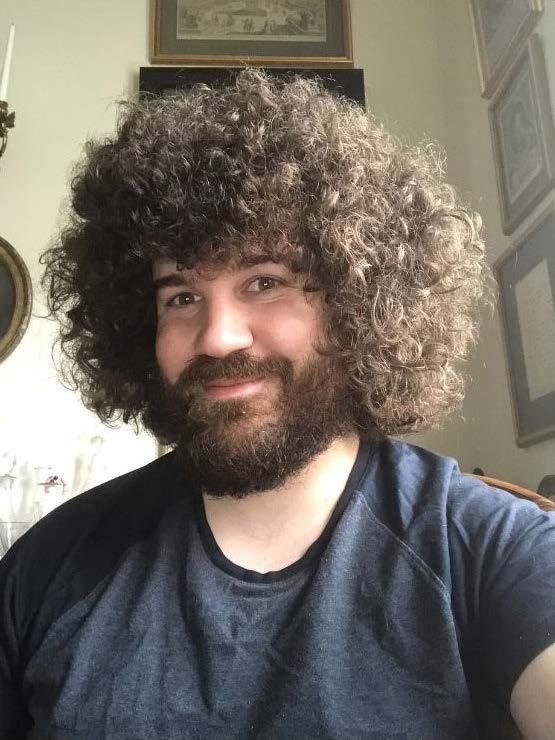
When things would get too intense in life, a sudden bout of compulsion would consume me. Everything needed to change. I needed to be different from the phase of my life I was running away from. Things take time, however. So, I would go to the nearest pharmacy and line my basket with the next color to soak myself in. If I had new hair, a physical change, it would help show the next stage of my being. Green, blond, brunette … and then I am pink. I am feminine and expressing myself. My hair is my badge of honor. Look, I have evolved. I am a woman. As I came to this pink being, I found myself shrouded in the love of my friends as we all entered our midtwenties. Embracing our womanhood, and with that the realization of being a woman. Laws that are set to confine, sexual harassment, and other unpleasantries. Always keep a smile lest you be marked as hysterical. Rise above. I continued to apply pink in heavy globs. As it was stripped away and the pink hair that was loved fell out, I truly felt like a woman. Stripped down and covered in pink. Wrapped in a nice bow even whenfalling apart.

52 53
Hair/Cut
Styling Identities
Richard Koopman associate curator of American decorative arts
Erik Bowen, theater and A/V projects manager
During the pandemic, my hair grew longer than usual, as seen in this photo. Normally, I rely on Tamie Le, my stylist of over two decades, who’s been cutting my hair since her days at a salon in Westfarms Mall. Later she opened her own place, Salon Time, on the Berlin Turnpike.

However, when her shop closed during the lockdown, I was in a hairy predicament. Long hair wasn’t my style— it made my neck sweaty, tickled my ears, and irked my forehead. The bigger issue was my complete lack of hairstyling skills. Should I rock the childhood comb-over my mom used to enforce (which a college classmate once hilariously said made me look like I was hiding a bald spot)?
Or should I risk a DIY haircut, even though I knew it was a disaster waiting to happen? So I impatiently awaited the reopening of businesses. Finally, on June 19, 2020, I had my appointment with Tamie, and the photo you see here captures the aftermath of four months of hair growth being expertly sheared away. My head felt incredibly lighter.
 Susan Bass
Susan Bass

Hair is about self-esteem. Curly, frizzy hair is unacceptable. Hide it any way possible. Set it, iron it, straighten it. But when you can, on a good day let it be smooth, long, and flowing. For then you feel beautiful. Whereas on a rainy, humid day, you want to hide under a hat. Or stay inside. Hair can be a rite of passage. As we age, most of the time we can handle our hair or at least run quickly to a salon and ask to be saved. But what happens with age? We start to go a little insane.
It gets brittle, white, or gray and then the worst happens. Piece by piece it leaves us. It falls to the bathroom floor each day. We see less and less on our heads. Unless you’re a lucky one. Not me. Each day I work and work longer on trying to fluff it out so no one can see the spaces. I’m happiest now wearing a hat or a wide headband. Until someone notices the gaps around the edges. I worry now not so much about getting old, but about having enough hair to grow old with. Hair is about self-esteem and mine falls more each day.
54 55
Styling Identities
Hair/Cut
Object Snippet : Vicomtesse Simon de Vaulchier
by Margaret Foote Hawley
Margaret Foote Hawley (American, 1880–1963) 1929
Watercolor on ivory Gift of Miss Roswell Hawley and Mrs. Louis L. Coudert, 1965.17
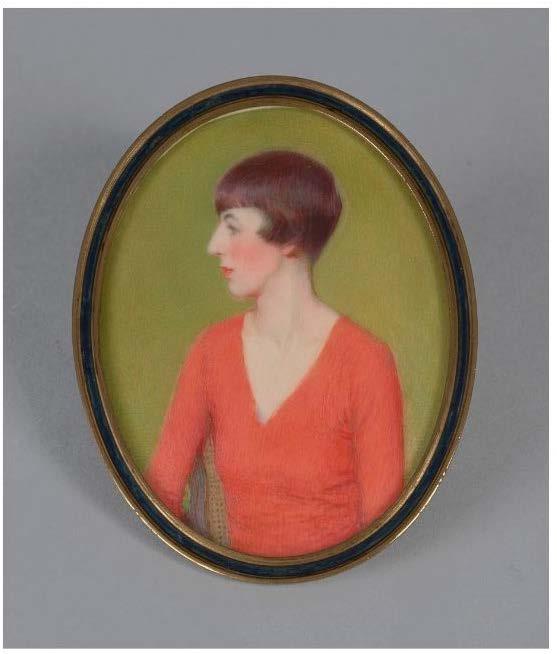
The 1920s marked the first time in recorded Western fashion when the desirable hairstyle for women was short. Post-WWII, beauty was modernity, and modernity meant a reduction of female hair, both on the body and on the head. In the 1920s, fashionable hairstyles manifested themselves in the bob and the shingle. The first was characterized by a blunt cut at or around the jawline. The second, also known as the Eton crop (named after its resemblance to the hairstyle of boys at the prestigious English boarding school), was even more radical. The hair at the back of the head was layered, or shingled, making the rounded shape of the head plain. Longer side lengths covered the ears. The shingle is the hairstyle seen in this miniature.
We don’t know too much about the sitter, Dorothy Edinger. She was born in San Francisco on January 26, 1895. On July 26, 1926, she entered the ranks of nobility with her marriage to Marie Louis René Simon de Vaulchier (1893–1971). Painted by Hawley three years later, paradoxically in the centuriesold technique of watercolor on ivory, the vicomtesse appears before us as the epitome of the modern woman. Her hair echoes the sleek lines and abstracted shapes of the 1920s. Rather than having the prominently defined, chemically set waves or curls promoted for these shorter hairstyles by the fashion press and burgeoning beauty industry, the vicomtesse opted to keep her short hair natural, with only the slightest (probably natural) wave of her hair to add body to it. The hair may be its natural color, or perhaps dyed.
In addition to her hair, the sitter’s modernity is expressed through her clear use of makeup (painted lips and eyes, and possibly rouged cheeks). Her loose, V-necked bodice (possibly a knitted sweater, or a woven silk crepe dress—you can see the wrinkles in it) and relatively relaxed posture also speak to a youth and confidence not manifest even fifteen years before in women’s dress. The absence of visible jewelry contributes to the streamlined, sleek look.
For all its modernity, the sitter’s white skin, enhanced by the ivory substrate, does not seem to tap into the vogue for suntanned skin at this time. And by the 1930s, fashions would change again, encouraging more women to perm their (longer) hair even more. Clothing became more decorative, echoing the more intricate hairstyles. But for the late 1920s, the vicomtesse’s hair and dress terrifically encapsulate the modernity of the time.
56 57
Ned Lazaro, associate curator of costume & textile
Hair/Cut
Styling Identities
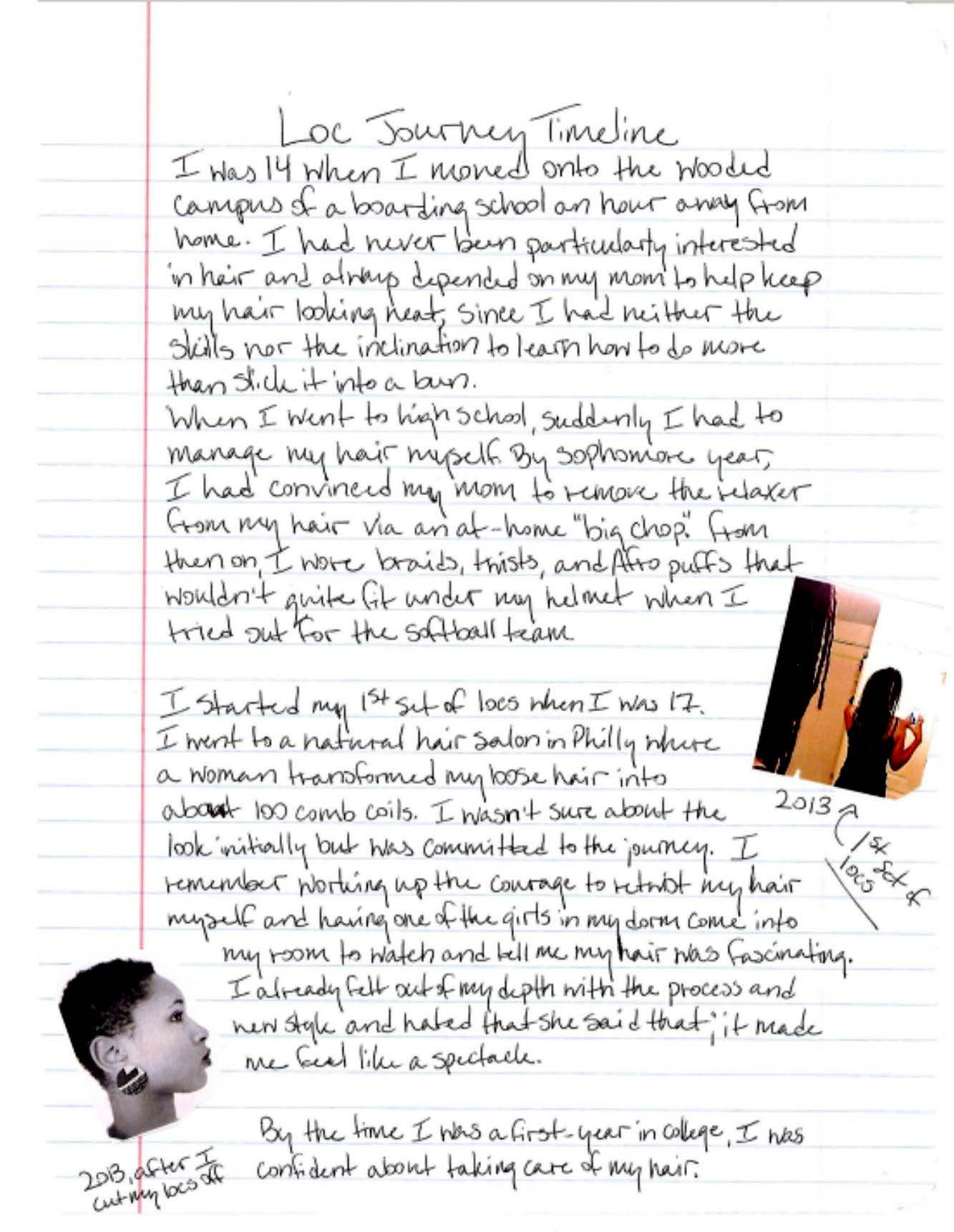

58 59 Hair/Cut Styling Identities
Chloe Collins, Styling Identities co-curator and managing editor of the Zine
Hair/Care
Have you ever helped comb, style, or wash someone’s hair? These are intimate and tender acts of caring. From performing hair care rituals to keeping a treasured lock from someone dear tucked away in a special place, love often shows up in the way we think about and tend to our hair.
Cabello/Cuidado
¿Alguna vez has ayudado a peinar, estilizar o lavar el cabello de alguien? Estos son actos de cariño íntimos y tiernos. Desde realizar rituales de cuidado del cabello hasta guardar un preciado mechón de alguien querido en un lugar especial, el amor a menudo se manifiesta en la forma en que pensamos y cuidamos nuestro cabello.
Adrian Martinez Chavez
Untitled, 2016

60 61
Styling Identities
Hair/Care
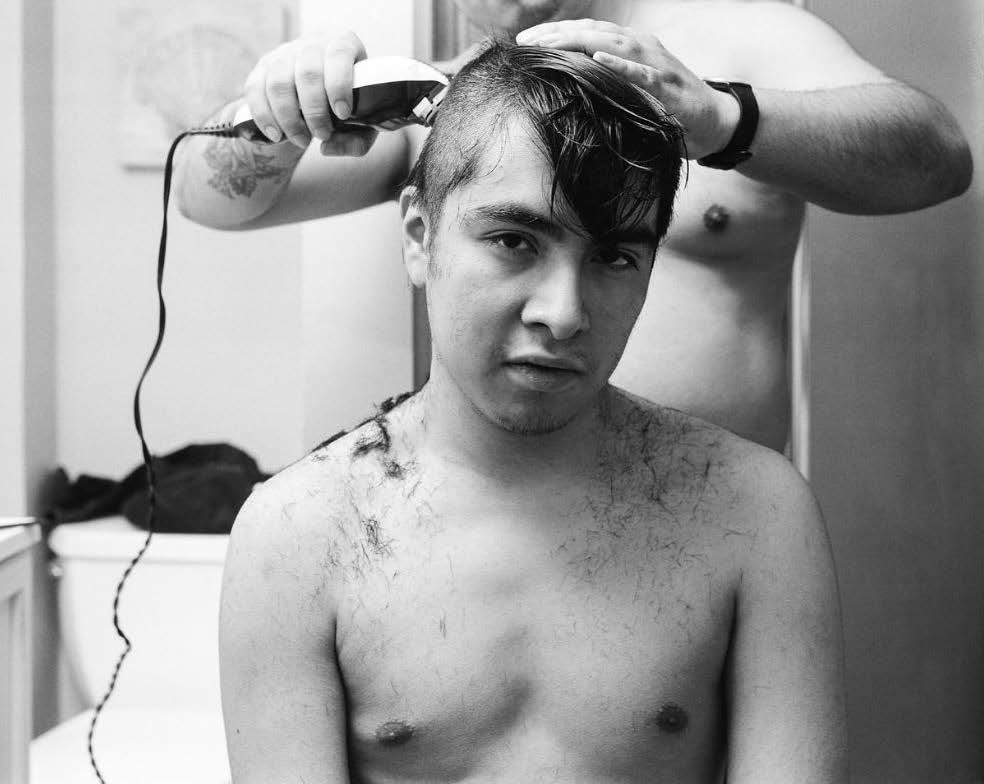
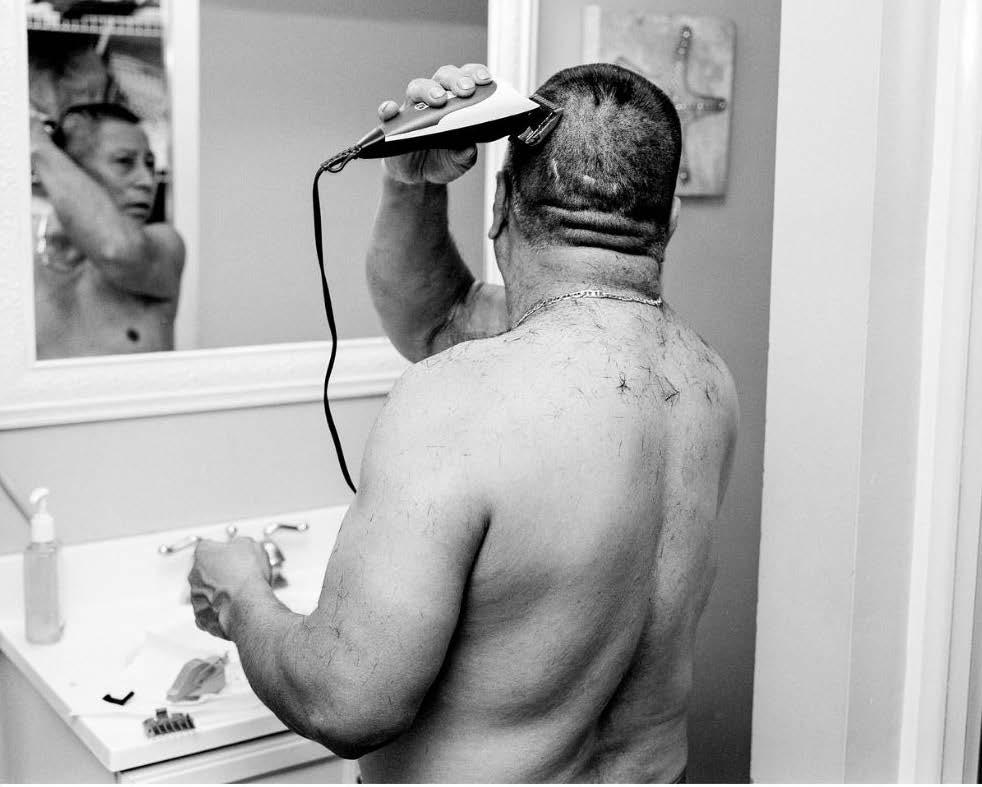
62 63
Styling Identities Hair/Care
Untitled (Marco), 2020
Untitled (Corte de Pelo), 2020
Rosanne Daigneault
Carol’s Salon of Beauty
Barn-red, gambrel-roofed, Carol’s Salon of Beauty cornered at Hillside and White.
Saturday morning, ladies only.
Pink-rolled, heat-set, metal sizzles…
Vertically posted, tubular helmets rise and fall, permanently waving us to womanhood.
Paulina Yi
Untitled
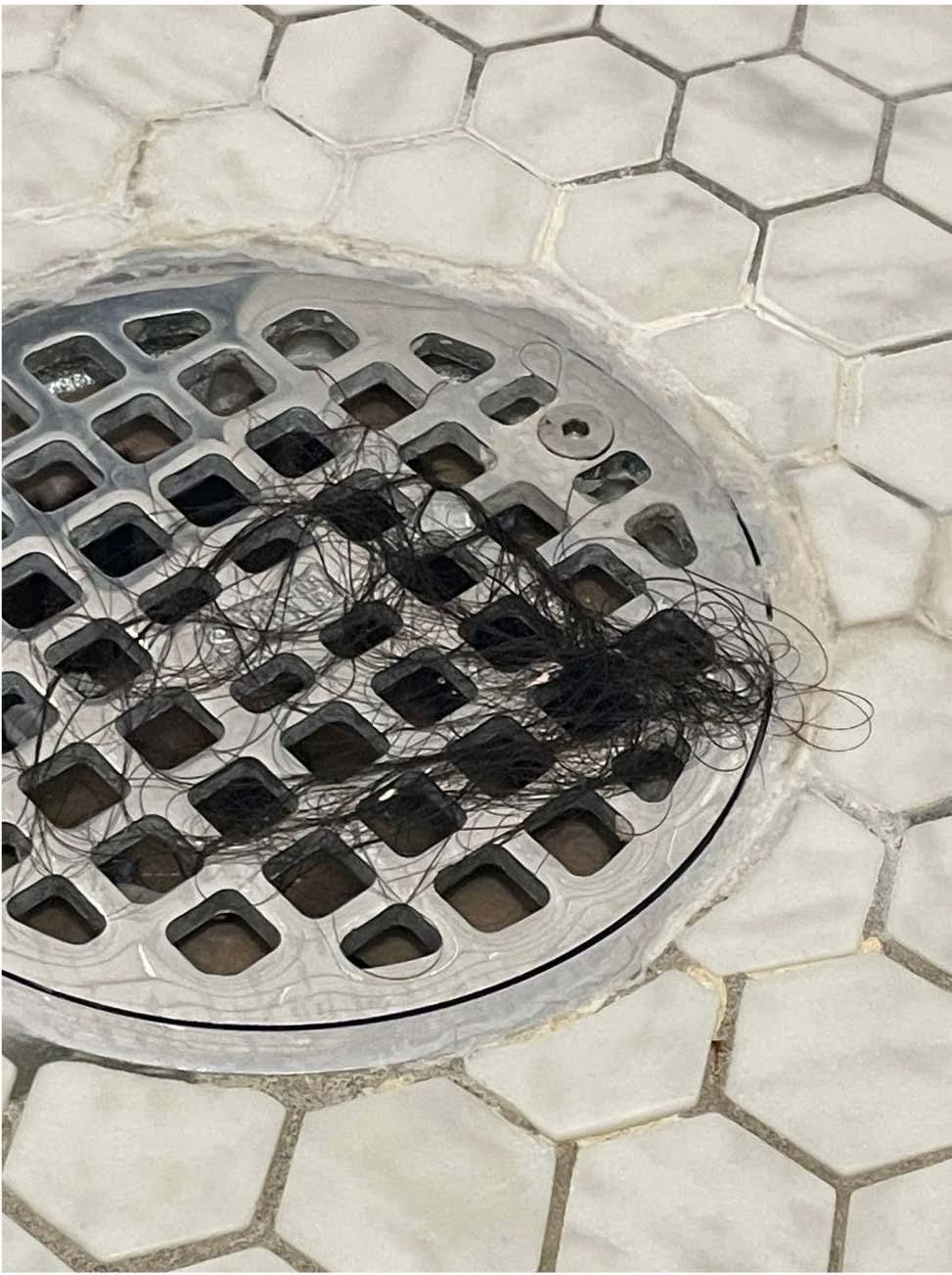
64 65
Hair/Care
Styling Identities
Flowers

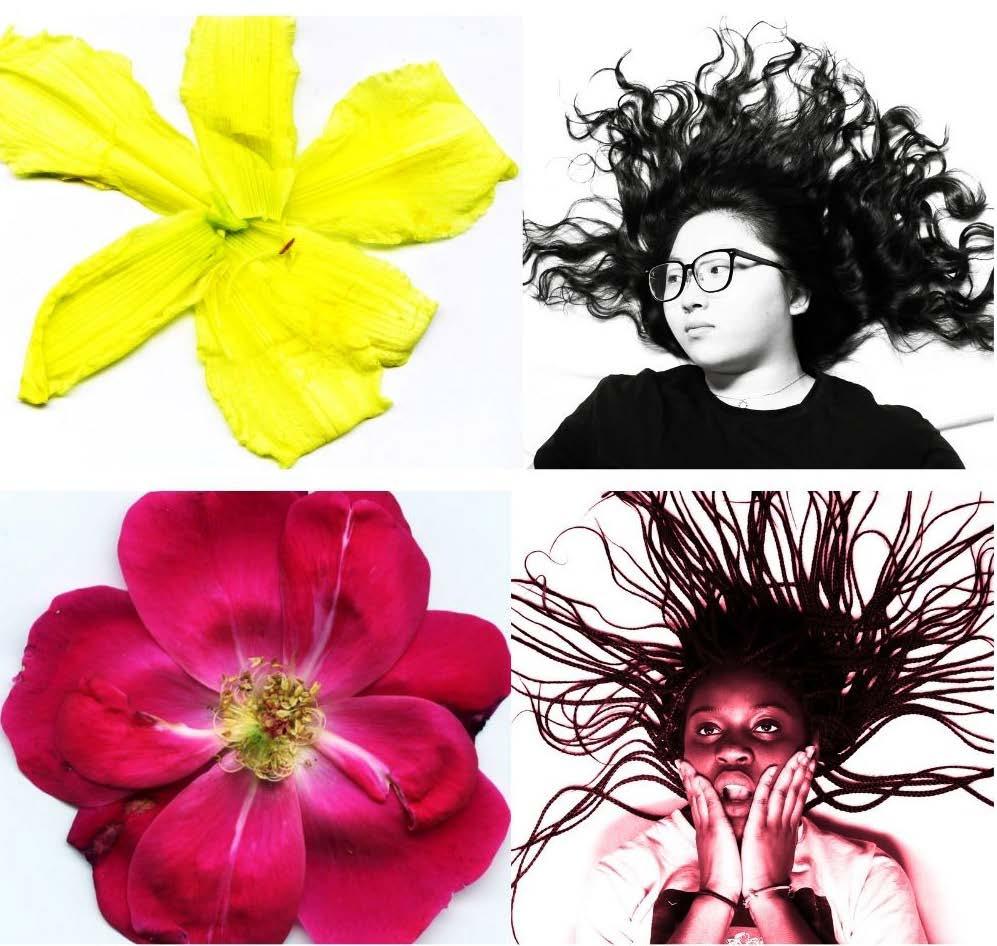
66 67 Styling Identities
Hair/Care
Jama Holchin, Styling Identities curator
Natalia German
Annmarie Gioscio
Impulsive Bangs Zine
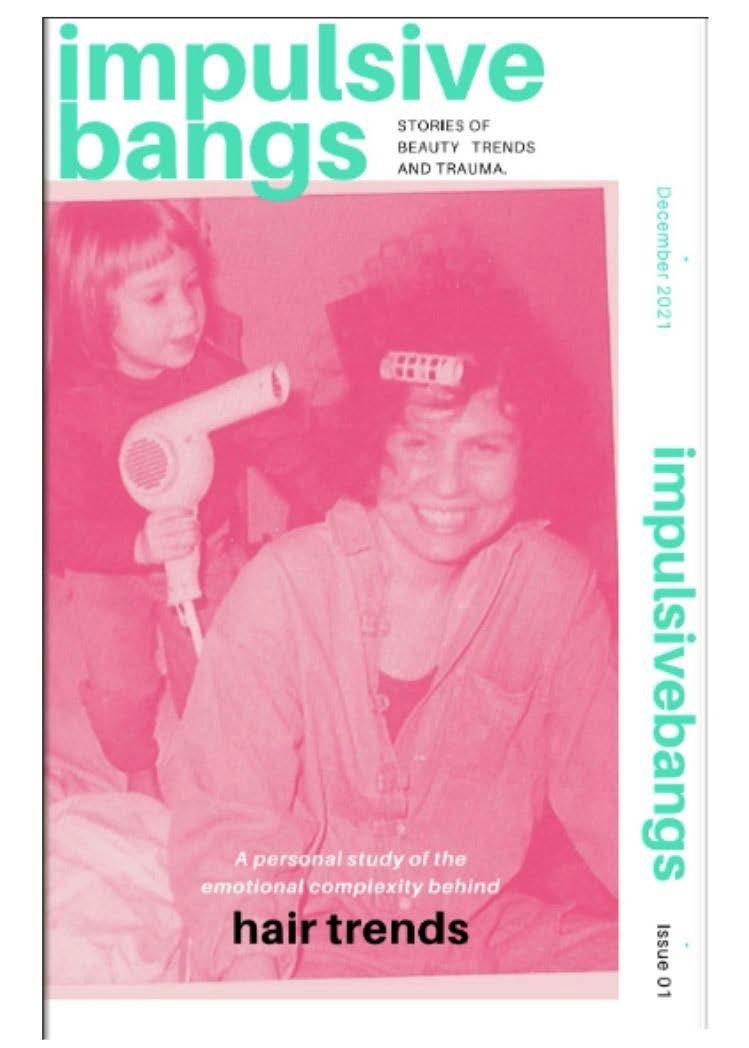
 Jasmyne Pinkey, owner of BASWA Hair Cultivating Studio
Jasmyne Pinkey, owner of BASWA Hair Cultivating Studio
BASWA Hair Cultivating studio was established in the year 2000 by the Lawrence sisters Brenda & Sallie. As the current CEO I continue the BASWA (Brothers And Sisters Working Art) Mission: To provide a quality service in a serene atmosphere that uplifts the Mind, Body, and Spirit of our clients.
I observed my aunt and my mother (Brenda Lawrence/ Sallie Pinkney) establish BASWA Hair Cultivating Studio from ground zero. I remember answering the telephone and cleaning up in the salon as a little girl. I eventually began assisting other stylists with clients, shampooing, caping, and detangling natural hair. With a natural gift for cultivating hair, I began her career as a natural hair care specialist.
Through my educational journey, I realized that I had a full passion for hair. After graduating from Springfield College with a bachelor’s degree in health science, I went on to enter the world of cosmetology via the International Institute of Cosmetology, graduating second in my class in 2014. I passed the State Board of Cosmetology exam in the top percentile and established myself as one of the top natural hair cosmetologists in Connecticut.
After being groomed by my terminally ill aunt Brenda, I became a partner of BASWA. I was forced to quickly learn the business and discovered a variety of ways to expand the BASWA brand. Shortly afterward, I was thrust into taking the reins and became the main partner and quickly learned the true definition of ownership. Under my leadership, BASWA has soared to new heights and is operating using the latest technology and 21st-century equipment while continuing the family legacy.
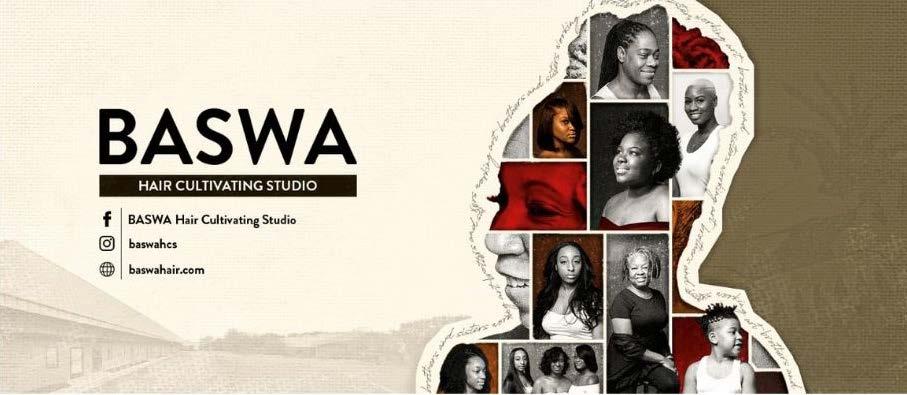
68 69
the full issue!
Read
Styling Identities
Hair/Care
Meg Smith, visitor services operations manager
From the Root (Hair Follicles)
 Brigitte Reyes
Brigitte Reyes
Curly Confidence
This artwork is more than just a canvas; it’s a representation of my journey toward selfacceptance and selfconfidence. For a long time, I struggled with my curly hair, influenced by the perception of many who deemed it less appealing. The pressure to conform to the idea of straight hair weighed on me. However, Curly Confidence is a reflection of the moment when I embraced my natural hair and found the beauty in it. It symbolizes my journey toward self-love and acceptance.

The transformation represented in this artwork adds to its vibrancy. It is a symbol of hope for everybody who has been compelled to conform with traditional rules. To illustrate the universality of this experience, I chose my partner as the model, underlining that men, too, confront comparable struggles and may find beauty in accepting their true self.
70 71
Styling Identities
Hair/Care
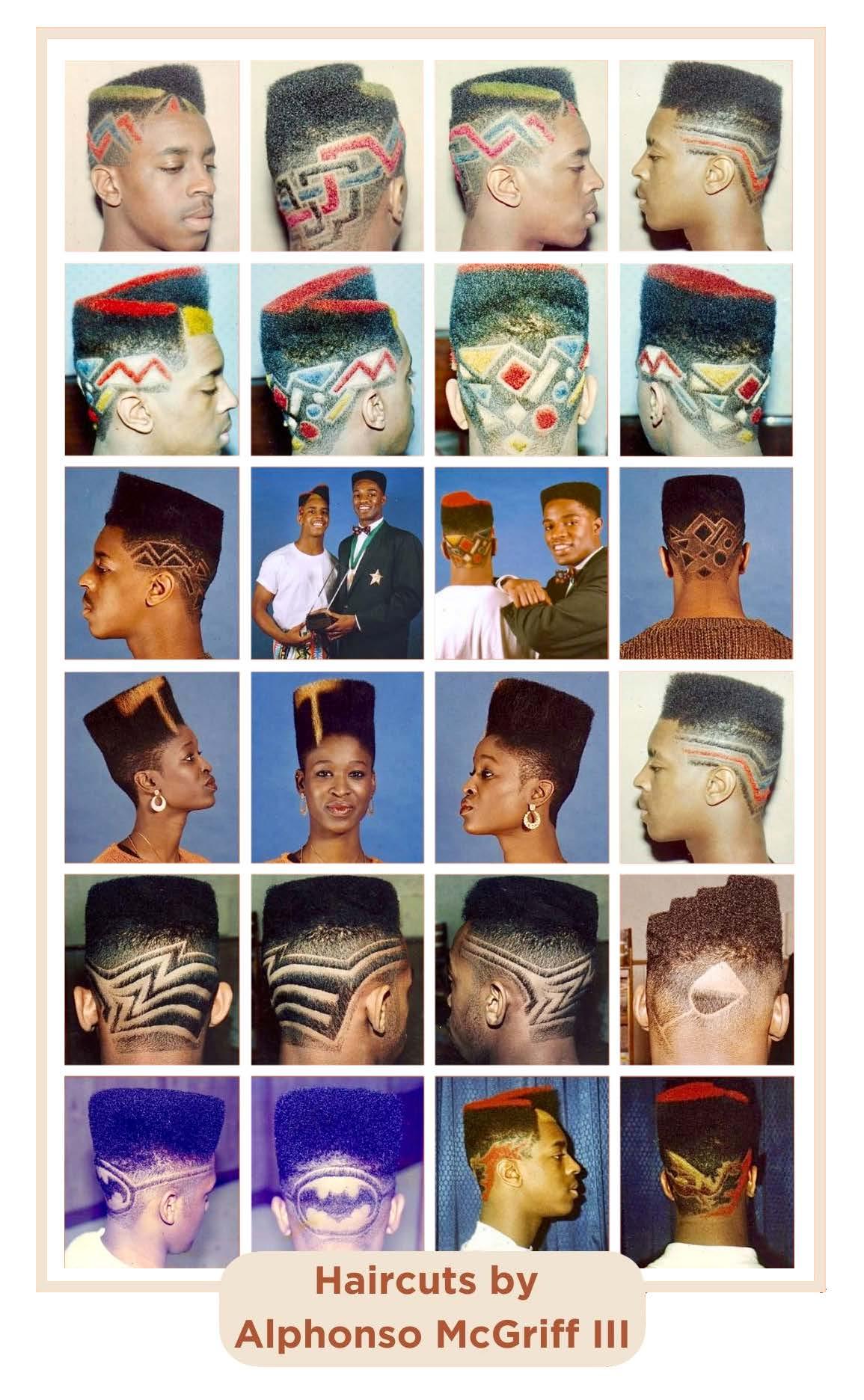
3 Facts About My Hair

72 73 Styling Identities
Lucy Li,
Hair/Care
Alphonso McGriff III
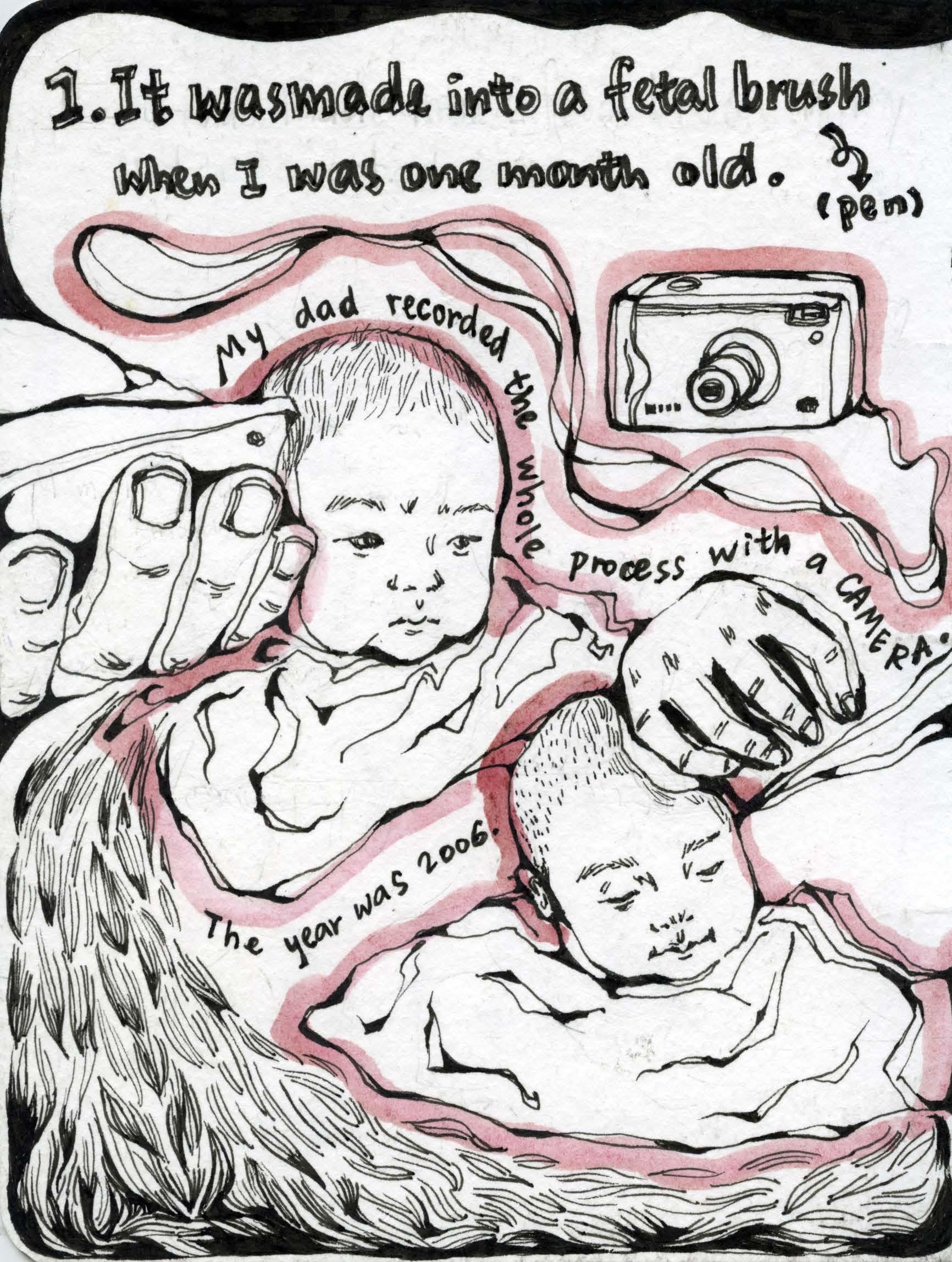
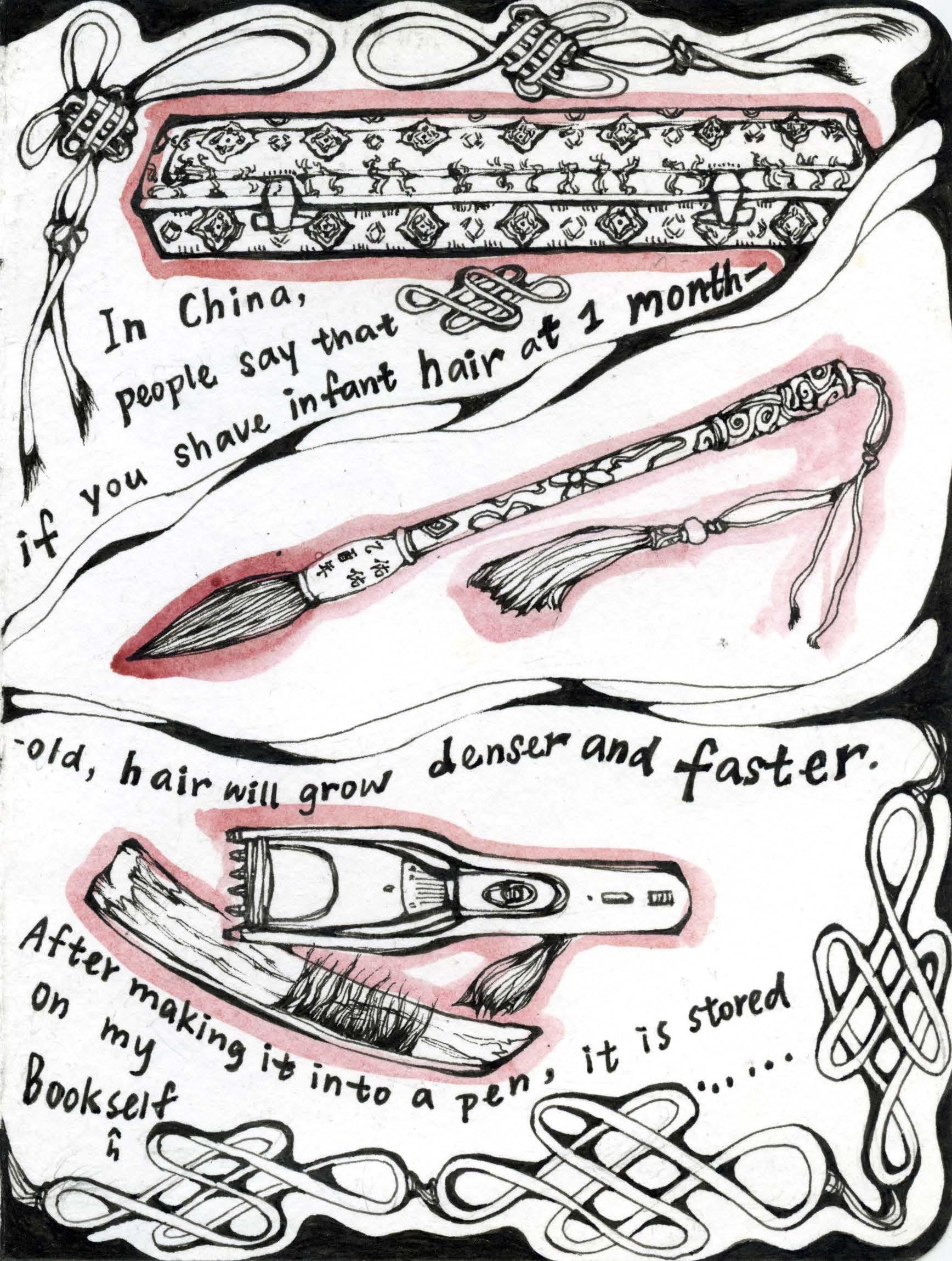
74 75 Styling Identities Hair/Care
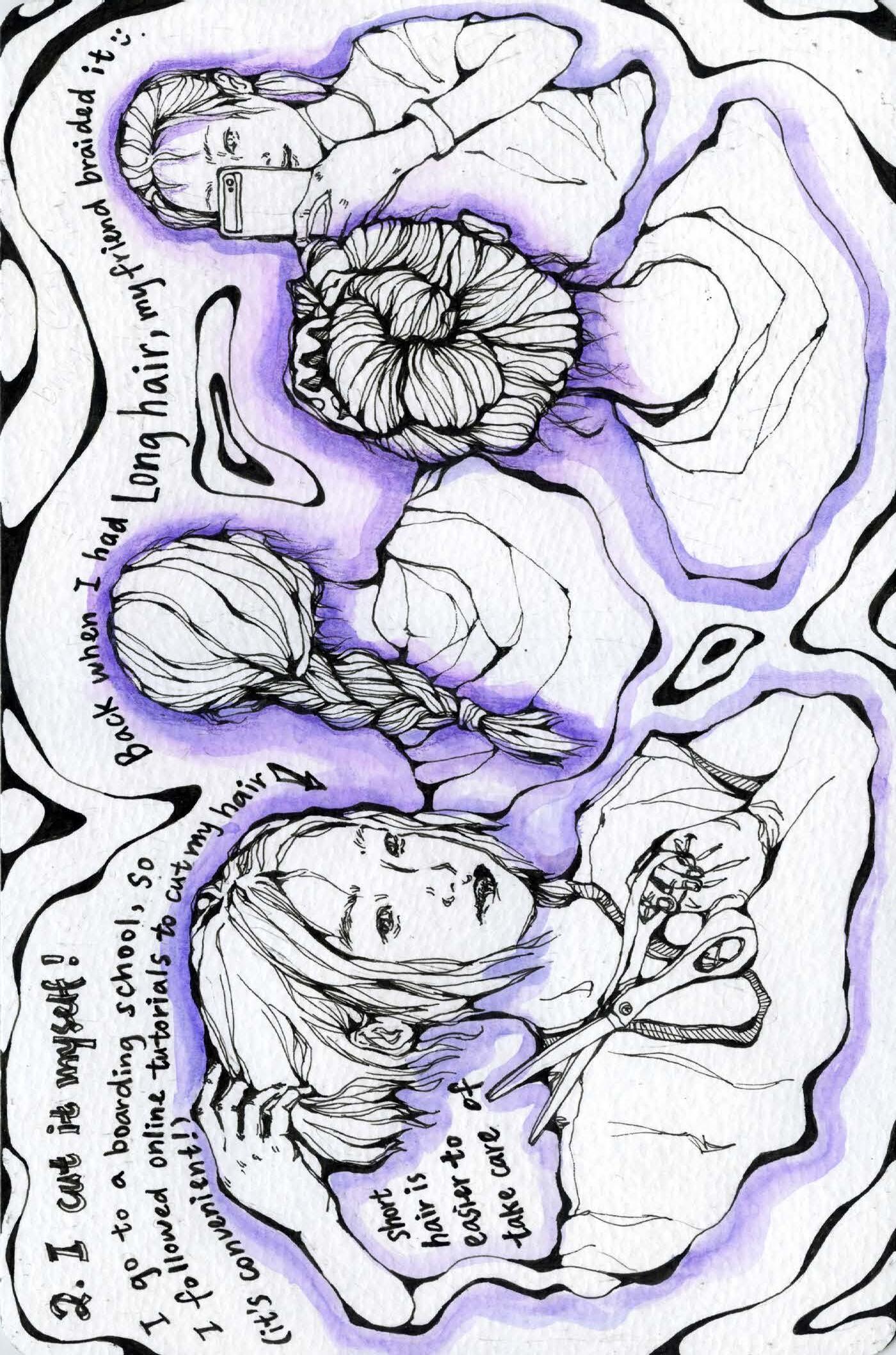

76 77 Styling Identities Hair/Care
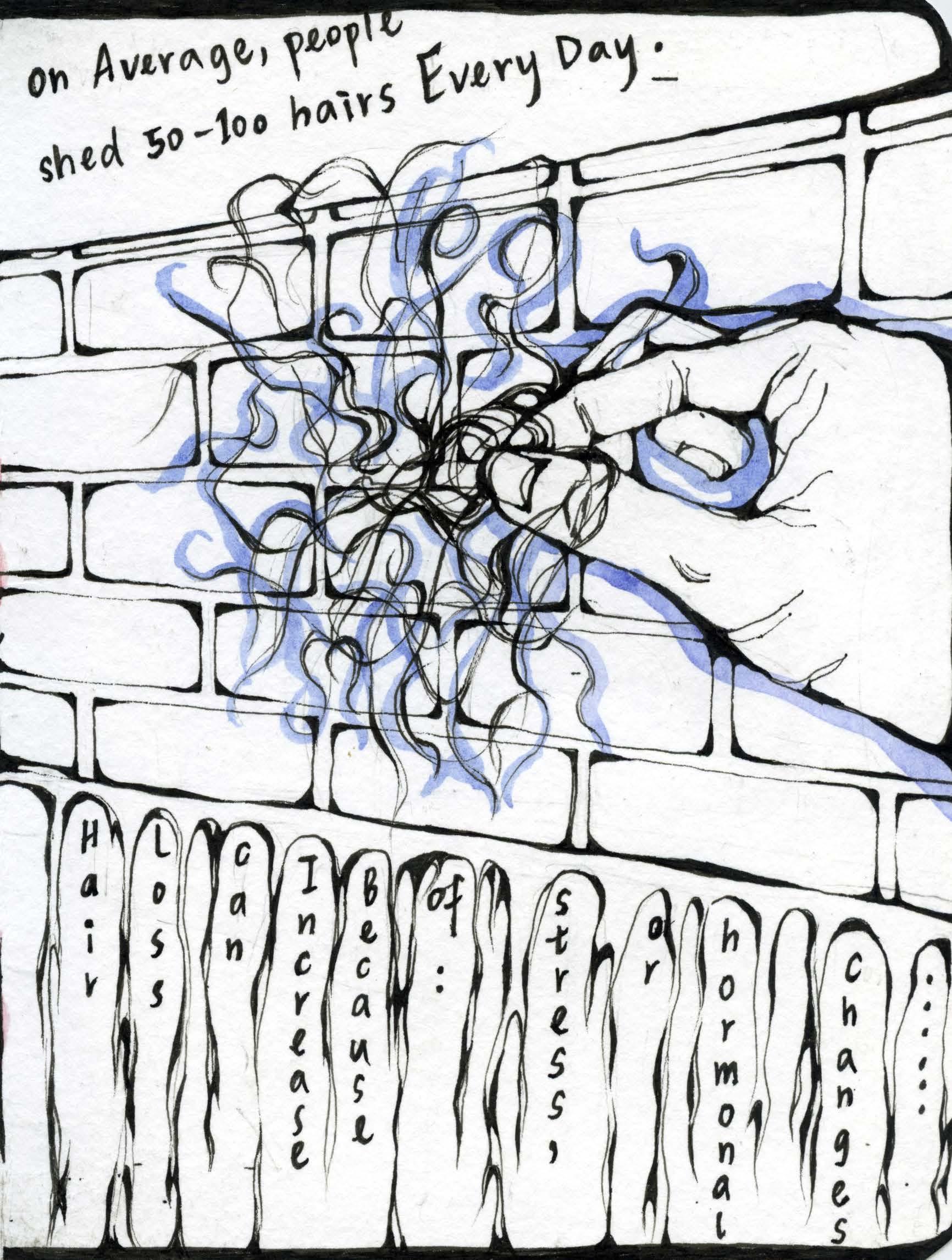

78 79 Styling Identities Hair/Care

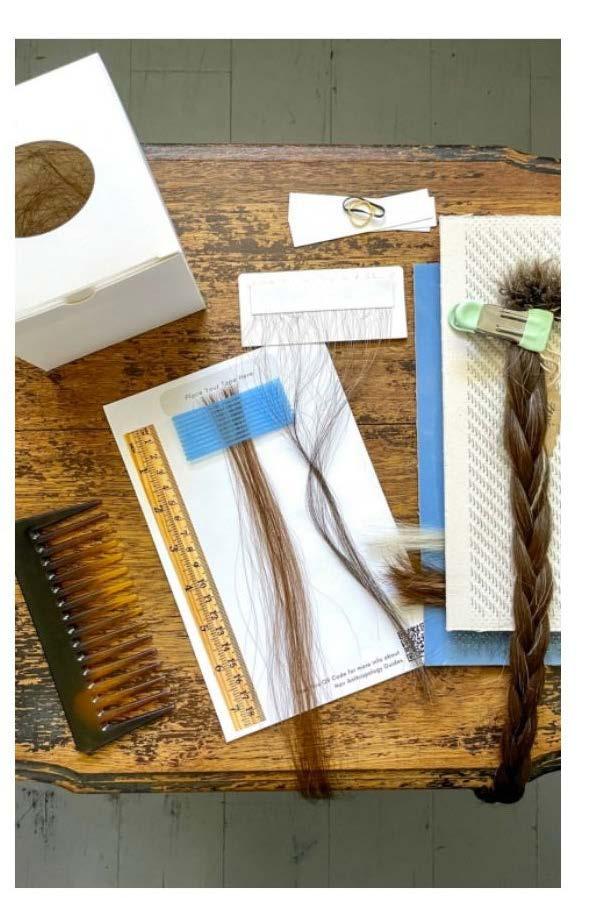
80 81 Visit hairanthropology.com for more information about Hair Anthropology guides Styling Identities Hair/Care
Zen Hansen
Excerpt from
The
Hair Anthropology Guide to Hair Collection


82 83
Beth Malley, docent
Styling Identities Styling Identities
Good Luck Girl
Beth Malley, docent
Hair/Care
Overwhelmed Busy Girl
Francine Austin, CEO Francine Entertainment & Marketing, Owner of Francine’s Salon & Day Spa & The Amistad Center for Art & Culture Trustee
Hair is my story; I was born to be an entrepreneur. I am a stylist and visionary whose ability to connect with clients goes far beyond the chair. As a renaissance woman with an infectious enthusiasm for life, philanthropy, and a passion for the arts, I believe that hair is the greatest form of selfexpression. Hair is confident and classy. Hair is bold and beautiful. Hair is sleek and sassy. Hair is joy and pain. Hair is cultural. Hair marks an era in time. Hair is change. Hair is always evolving.
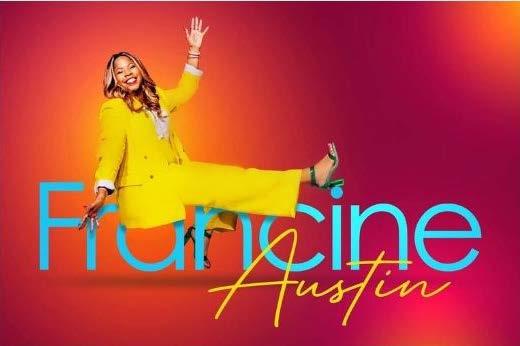
With that said, I took a risk and decided to change my narrative. I left the corporate world and launched Francine’s Salon & Day Spa, the first Black-owned salon and day spa in Bloomfield, CT. For over 20 years, it has been a place where everyone is welcome.
This is where my HAIRstory begins. Francine’s Salon & Day Spa is where art and philanthropy intersect. It’s a colorful tapestry woven of clients young and old, stylists and stations, hair (curly or straight), cuts and cornrows, wigs and weaves, wildest dreams, braids and bows, mothers and daughters, shampoos and styles, brushes and blow dryers, mentors, and mentees.
It is a sisterhood where secrets are shared, achievements are celebrated, laughter is loud, and lifelong friendships are made. It’s an experience—a place just for us. Francine’s is a salon where a woman’s beauty and hair are respected and celebrated, regardless of ethnicity. Hair is diverse and multifaceted. Hair is where HERstory lies.
Historically, a black woman’s hair was her crown and glory, and this is still true today. This is where MYstory begins. Growing up I would sit in the kitchen where my mother would straighten my long thick hair with a hot comb for Sunday church service. I would sit in the chair for hours listening to my mother and aunt Carol sharing stories and laughing. It was these exact moments that helped define who I am today. My great-great aunt, Anna Medlock, was a graduate of the Madam C. J. Walker School of Beauty in New York. Madam C. J. Walker was African American and the first female self-made millionaire. She was the owner of Madam Walker’s Wonderful Hair Grower, an entrepreneur, philanthropist, and political and social activist. My Aunt Rozella Moreland was owner of Re-Vive Beauty in Hartford, CT for over 55 years. They were my window into the world of beauty where art, philanthropy, business, women’s rights, and racial equality existed simultaneously.
As a business leader and a member of the State of Connecticut Board of Cosmetology and Barbering, I make it my mission to give back. My mentee Jamelle White is an amazing young lady whose talent for braiding is exquisite. Each of her styles tells its own unique HAIRstory. She has worked at my salon since she was in high school, throughout college and law school, and has a thriving career. I believe you can make space for your passion and business to coexist. I apply that philosophy to whatever I do. There is no greater feeling than the look on your client’s face after they look in the mirror. HAIR at Francine’s; you’re a cut above the rest!
84 85
Hair/Care Styling Identities
Zifan Wei
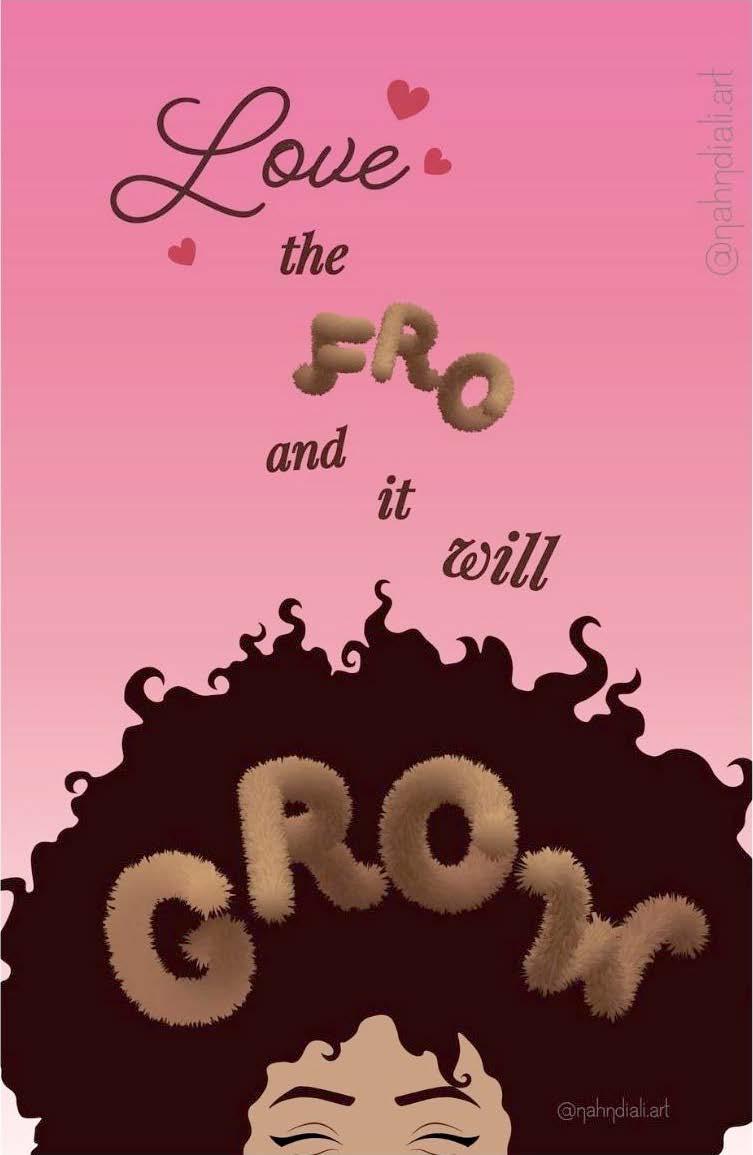
I made this piece when I was reflecting on conversations surrounding Black hair, specifically how looser textures and long curly hair are desired for Black women. I would see women with Afro or tighter curl patterns wish they had loose waves or manageable hair, often called “good hair.”
I’m happy to see more and more Black women embracing the beauty of each kink and coil, and prioritizing the health and care of their hair rather than preserving a colorist ideal.

86 87
Untitled Hair/Care
Styling Identities
Nahndi Ali, gallery attendant and front desk
Katherine Zhong
Hair/Tangles
Have you ever felt pressured to wear your hair a certain way? Or felt judged for the style you prefer? Social stereotypes around hair and the ways we style it are intertwined with racist and sexist notions embedded within our culture. This can profoundly impact not only our relationship with our hair but also with ourselves and each other. Many artists strive to counter these harmful stereotypes and messages with powerful works of art exploring hair as subject and medium.
Cabello/Enredos
¿Alguna vez te has sentido presionada a usar tu cabello de cierta manera? ¿O te sentiste juzgado por el estilo que prefieres? Los estereotipos sociales en torno al cabello y la forma en que lo peinamos están entrelazados con nociones racistas y sexistas fundadas en nuestra cultura. Esto puede afectar profundamente no sólo nuestra relación con nuestro cabello sino también con nosotros mismos y con los demás. Muchos artistas se esfuerzan por contrarrestar estos estereotipos y mensajes dañinos con poderosas obras de arte que exploran el cabello como tema y medio.
Tangled

I was inspired by Pepón Osorio’s En la barbería, no se llora (No Crying Allowed in the Barbershop) and wanted to create my memories about hair. I immediately thought of the experience of my mom trying to untangle my hair regardless of my pain. I liked my wild hair!
88 89 Styling Identities
Hair/Tangles
Jadyn DeWitt-Smith
Tender-headed
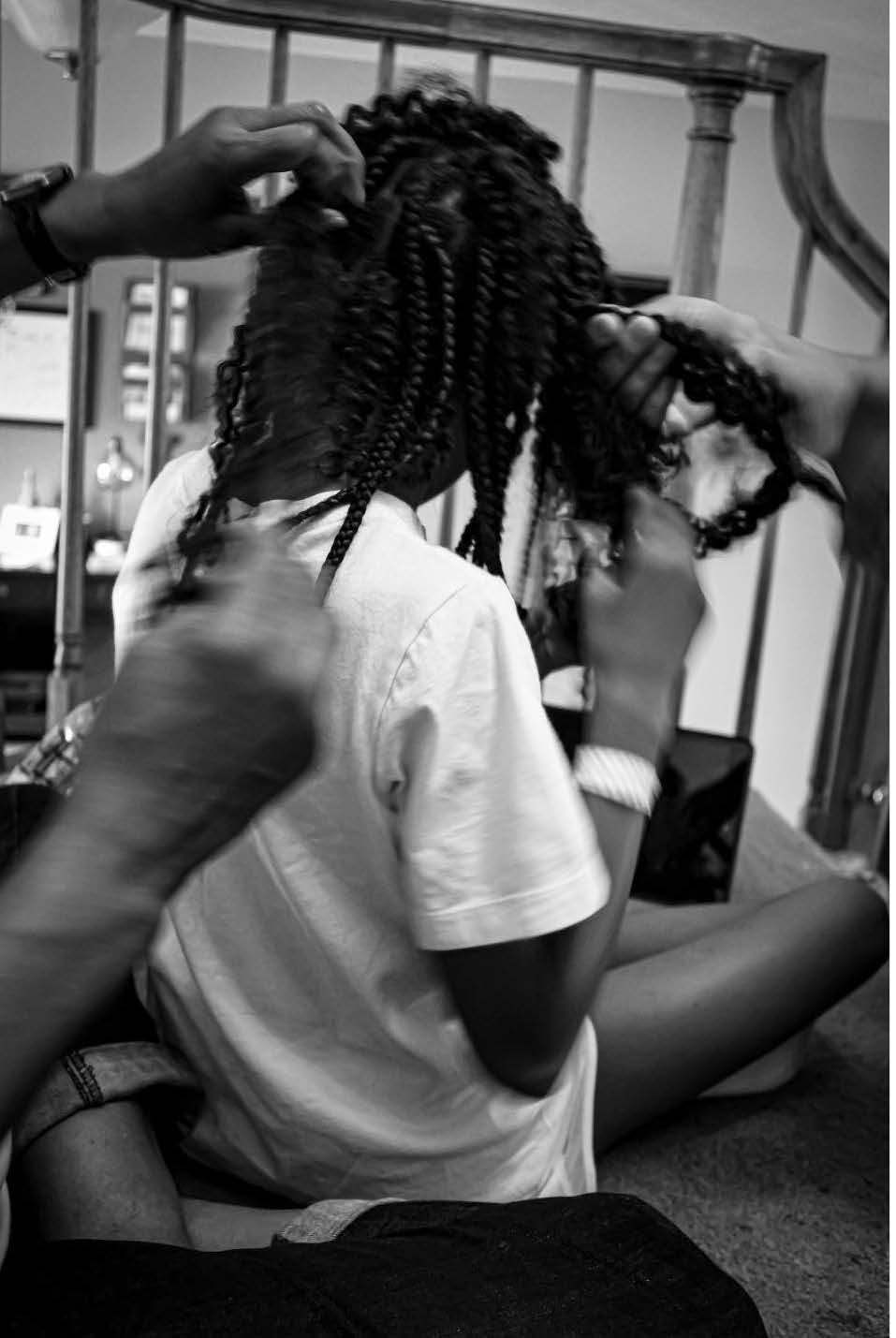

90 91
Styling Identities
Crown
2023, inkjet print
Hair/Tangles
2023, inkjet print
Katie Bennet
Boy Cut
At Kids Kuts I straddled a plastic frog like I was on a carnival ride. I ate a Dum-Dum and yanked on the neck of the black cape tied around my body. Just a trim please. My mom told the hairdresser this. I remember.
Maybe the hairdresser had spun me away from the mirror. Maybe I was too busy trying to bite the last bit of lollipop from its limp cardboard stem. Maybe Mom was looking out the window, leaning into the momentary reprieve of not having to watch me, not entirely. But as the hairdresser snip snip snipped, and I listened to the innocent, almost lulling cadence of her handiwork, she was transforming my identity without my permission. Mom and I did not notice until it was too late.
She had given me a “boy cut.”
I became an artist because I understood, so early, what it was to feel ugly. The morning after my haircut, I showed up at my preschool class and stood next to the doorway with my back against the wall. When my classmates noticed me, they laughed. They asked if I was a boy or a girl. They refused to play with me.
I had a dream around this time, one of the earliest dreams I remember, that I went to preschool naked. In my dream I am trying to find a place to hide. I crawl under a table and hug my knees, trying to squeeze my body into the smallest shape possible. Trying to disappear completely.
•
At 23 I sat on a wooden chair in a punk house in West Philly. Allison, the lead singer of one of my favorite bands, gently wrapped a towel around my neck.
Allison was otherworldly, wearing long wool ’40s coats with thick fur collars, or short ’60s dresses with bright matching stockings. When she sang she snarled, and laughed, and expanded to fill the entirety of my vision, no matter how large the room. Allison taught me a femininity rooted in joy, and wildness, and self-harnessed power.
And Allison had the most magnificent pixie cut I’d ever seen. One night our bands played the same show, and after her set I complimented her on her hair. I surprised myself by saying I was thinking of getting a similar cut. She said she cut her own hair, and would be more than happy to cut mine. As Allison cut my hair, I felt the tectonics of my selfhood rumbling. I could barely breathe from anticipation. I watched long strands of my hair fall to my feet. Like confetti.
92 93
Styling Identities
•
Hair/Tangles
Reflections on Venomous Coiffures

Arnold Böcklin
Swiss, 1827–1901
Shield with the Head of Medusa, c. 1887
Polychrome plaster and papier-mâché
Douglas Tracy Smith and Dorothy Potter Smith Fund, 2023.25.1
Emily Mae Smith
American, born 1979
Medusa, 2019
Silkscreen on paper
Printed at Powerhouse Arts Print Workshop
Gift of the artist, 2019.37.1

We are all familiar with having a bad hair day—but snakes emanating from our scalps? And does having bad hair make us be perceived as a bad person? Medusa can relate. She was one of the three Gorgons in ancient Greek mythology, famously known for her head of venomous snakes. She also wielded power as she could turn people to stone when they gazed at her. Do you want to send out an evil eye to anyone silently criticizing your undesired morning hairdo? Medusa’s crown of snakes is depicted in two art objects at the Wadsworth Atheneum Museum of Art, and I will venture that, with liberal interpretation, snakes could be seen in a third. I dare you to gaze into the eyes of Arnold Böcklin’s Shield with the Head of the Medusa, 1887. This monster has her own hair topped off with entangled serpents. In 20th-century feminism, the image of Medusa has been associated with a woman’s rage. If you woke up with a ratty head of hair, you would be enraged too.
Emily Mae Smith’s rendition of Medusa from 2019 features green undulating snakes protruding from a broomstick, fangs menacing on both snakes and face. No eyes to turn you to stone, but scary enough! The swirling coif could make anyone turn around and head in the other direction. Yet, the contrast of the bright pink background and slimy green scales entices us to look again. Do you ever find yourself staring at someone else’s hair arrangement and feel you must look away?
Vanessa German
American, born 1976 black on white swan, 2016 Mixed media
The Douglas Tracy Smith and Dorothy Potter Smith Fund, and purchased through a gift of Linda Cheverton Wick, 2016.10.1

Finally, I entreat you to look anew at Vanessa German’s black on white swan. A visitor recently told me that the white porcelain colonial figures on top of the Black figure’s head reminded him of Medusa’s snakes. The sculpture carries a history of oppressors on her head. Another visitor suggested that, by putting these statuettes on the power figure’s head, their meaning was reduced to just a hat. What do you think? Could black on white swan turn unruly people to stone? Does she have this kind of power?
Next time you wake up with a bad hair day, think of the power you might have in your grasp! Three different versions of Medusa with reptilian strands give us pause to stop and think about the ancient myth and how powerful women can be with their tangled hair.
94 95
Styling Identities
Hair/Tangles
Christi Moraga, docent
Najja Elon Lawson
The Trumpet

My hair story is a particularly complex one. In some instances, my hair has brought me closest to my truest form as a human being. Its allowed me to feel bold, unique, and authentic. But in other instances, my hair has placed me in disparaging situations that have caused me to be de-feminized, stereotyped, and generally ostracized. In the midst of those polar experiences, I always can find beauty within the balance of my masculine and feminine energy. My hair is a staple of courage. It is a trumpet flower that is equally bold, unique and authentic.
Nadia Sims
The L.O.C. Method
My angel was from a different generation
-The older ones flinch when water touches their hair-
Running my fingers through her ends
I felt her history of relaxers (the Just for Me No Lye formula will speak for itself); her ears bore Scars from a straightening comb.
Even though my hands were unfamiliar, Her stillness screamed that she refused
To be accused of being tender headed
I just wanted to take care of her
Co-Wash the memories of
Women who didn’t know better
From each strand
Detangle with my fingers. Combs
Cannot soothe and say “you’re safe”
Deep condition away worries
Liquid again (hurt and hydration
Cannot live in the same space)
Oils to seal and heal
And a Cream to close (all wounds need Bandages)
96 97
Hair/Tangles
Styling Identities
Richard Kirby
Nephele

I made this TikTok documenting my decision to dye my hair blond a few years ago. At the time, I was finishing my second year of law school and had a summer job lined up at a law firm. I felt some internal pressure to take the opportunity to flout the cultural and professional standards that are expectations of the profession I was pursuing. I kept the look for about three weeks, but I cut my hair prematurely to be “presentable” to my grandparents. Hilarity ensued.


98 99
Hair/Tangles
Styling Identities Sigi Ge
Scan code to watch TikTok
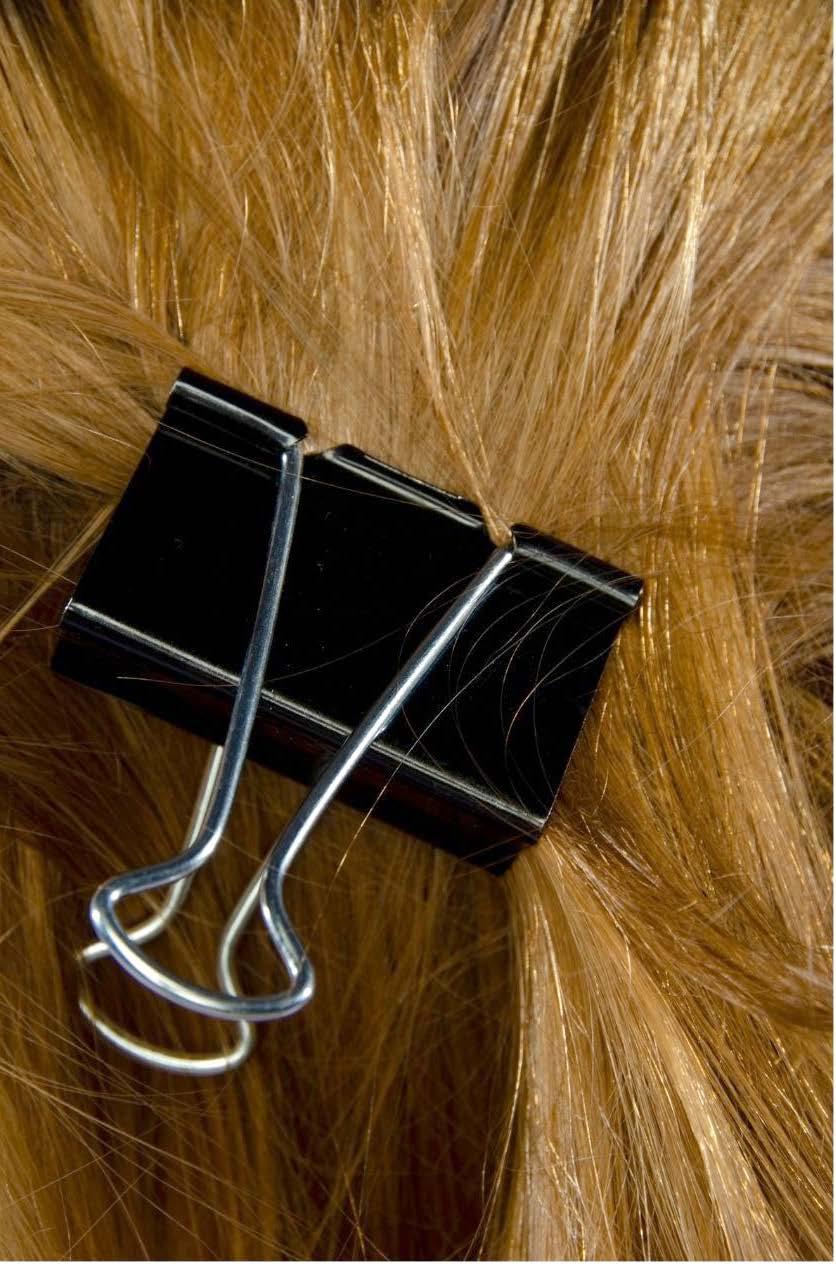
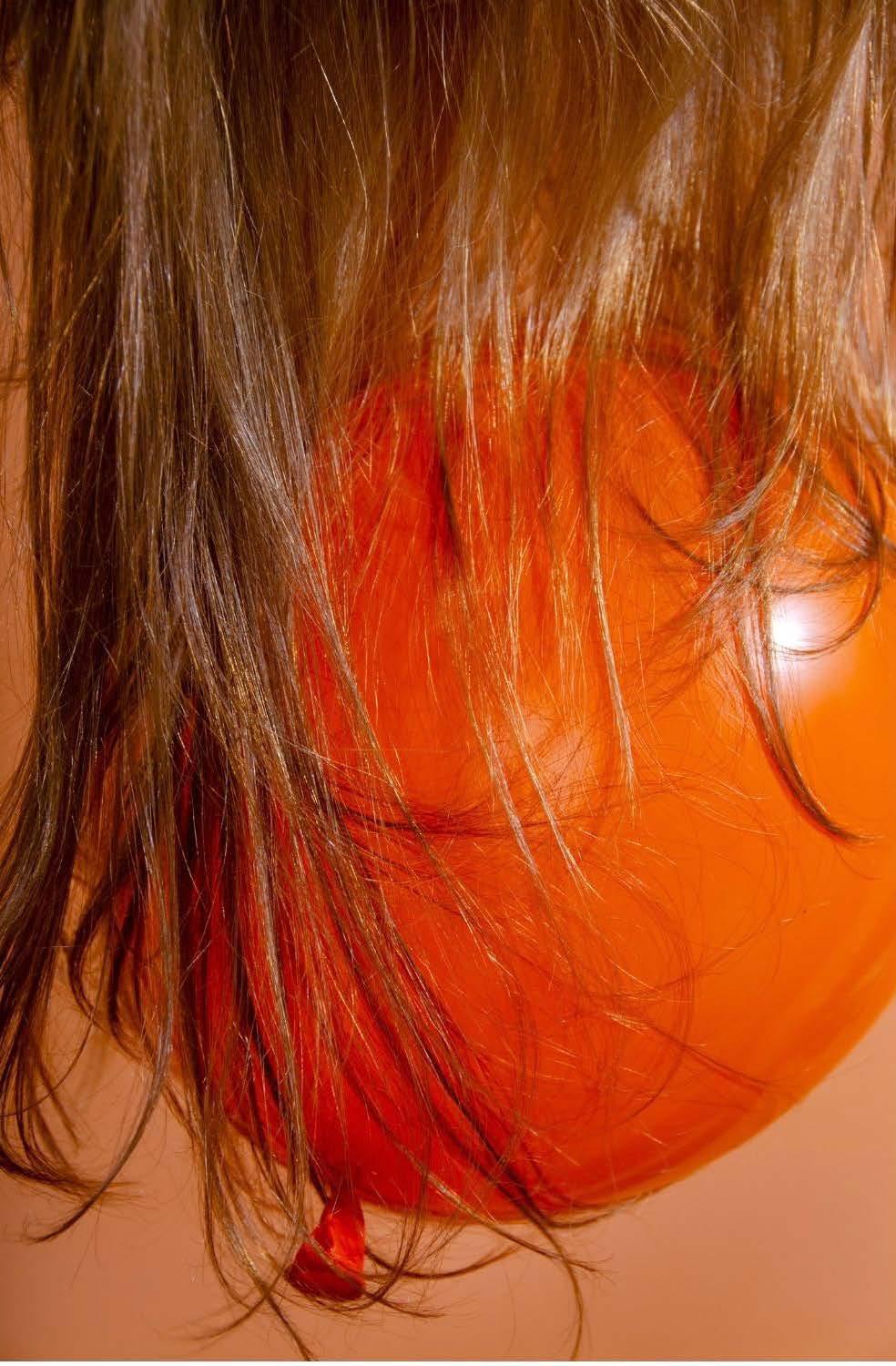
100 101 Hair/Tangles
Keri Halloran
Clipped Hair
Keri Halloran
Styling Identities
Hair Static
Isabella Kossivi
Artwork Reflection
Pepón Osorio
American, born Puerto Rico, 1955
En la barbería, no se llora (No crying allowed in the barbershop), 1994 Mixed media
Purchased through a gift from Southern New England Telephone in recognition of the vitality of Connecticut’s Puerto Rican community, and through the Alexander A. Goldfarb Contemporary Art Acquisition Fund, 1994.37.1

Pepón Osorio’s work En la barbería, no se llora (video and mixed media installation, 1994) is rooted in the culture of Puerto Rican barbershops, a place where you get haircuts. I feel like hair is as much a part of the Latinx community as it is for the Black community. My hair has always been an important part of me. My hair is what has set me apart from so many of my peers and friends. I was raised on Long Island, New York, and many of the people in my school were white. They had straight or wavy hair, nothing like mine. My mom would always tell me, “Don’t let people touch your hair.” I never understood until later. My hair wasn’t for people to touch. My hair was mine. For a very long time I would get my hair straightened, and I never really questioned why until I was around people who shared the same struggles as I do. When I moved to Manhattan, I still would straighten my hair most of the time. There were many times where people would ask me if my hair was real; one time a girl even pulled my hair to see if it was truly mine.
Something that has always upset me is that many people seem to believe that Black women have short hair. Black boys have made jokes to other Black girls saying, “My hair’s longer than yours.” I’ve never liked this joke because most of the time that wasn’t even true, but society had made them think it was uncommon for Black women to have hair longer than past their ears. Which must have been why I was always questioned when my hair was straight since it goes past my shoulders. My hair has always been about how other people perceive me. There were many times when I wanted to cut my hair, but I felt like I had to prove that it was possible for me to have longer hair than expected. I’ve never cut it.
Liz Calvi
Excerpts from Miss World

102 103 Hair/Tangles
Styling Identities


104 105 Hair/Tangles Styling Identities


106 Styling Identities
Carmen Veal Conway, owner Brown Skin Women & Styling Identities advisory board
Hair Texture: Unveiling the Unique Tale of Your Tresses
Every head of hair has its own captivating story to tell, a narrative of individuality etched into each strand. Hair texture is like a fingerprint, distinct and unique to you. It’s not just about appearances; it’s about behavior.

Virgin hair, untouched by alteration, can manifest as straight, wavy, loosely curled, or tightly coiled. This texture journey is influenced by various factors, including surface-level shine, strand density, moisture retention (porosity), and genetic determinants like length. Yet, the true narrative of hair health is written through daily habits.
But the story of hair texture is also a reflection of history—a history that has evolved over time. Once, tight curly hair was celebrated as a symbol of status and identity, before the dark era of slavery. During those challenging times, identity erasure became a harsh reality.
Yet, through resilience and courage, the narrative transformed. Hair adorned with accessories like turbans and Afros became a powerful expression of freedom during the Civil Rights Movement. Post-slavery, it saw changes, from chemical straightening to protective styles and loose curls, reflecting the dynamic nature of our heritage.
Today, the journey continues as tight curly hair, like all textures, finds new expressions and embraces its unique beauty. Your hair’s texture tells a unique tale, shaped by history and celebrated by the choices you make. Embrace and nurture your hair’s individuality to let it shine its brightest.

108 109
Styling Identities
Vanessa Sigalas, Styling Identities curator


110 111 Styling Identities
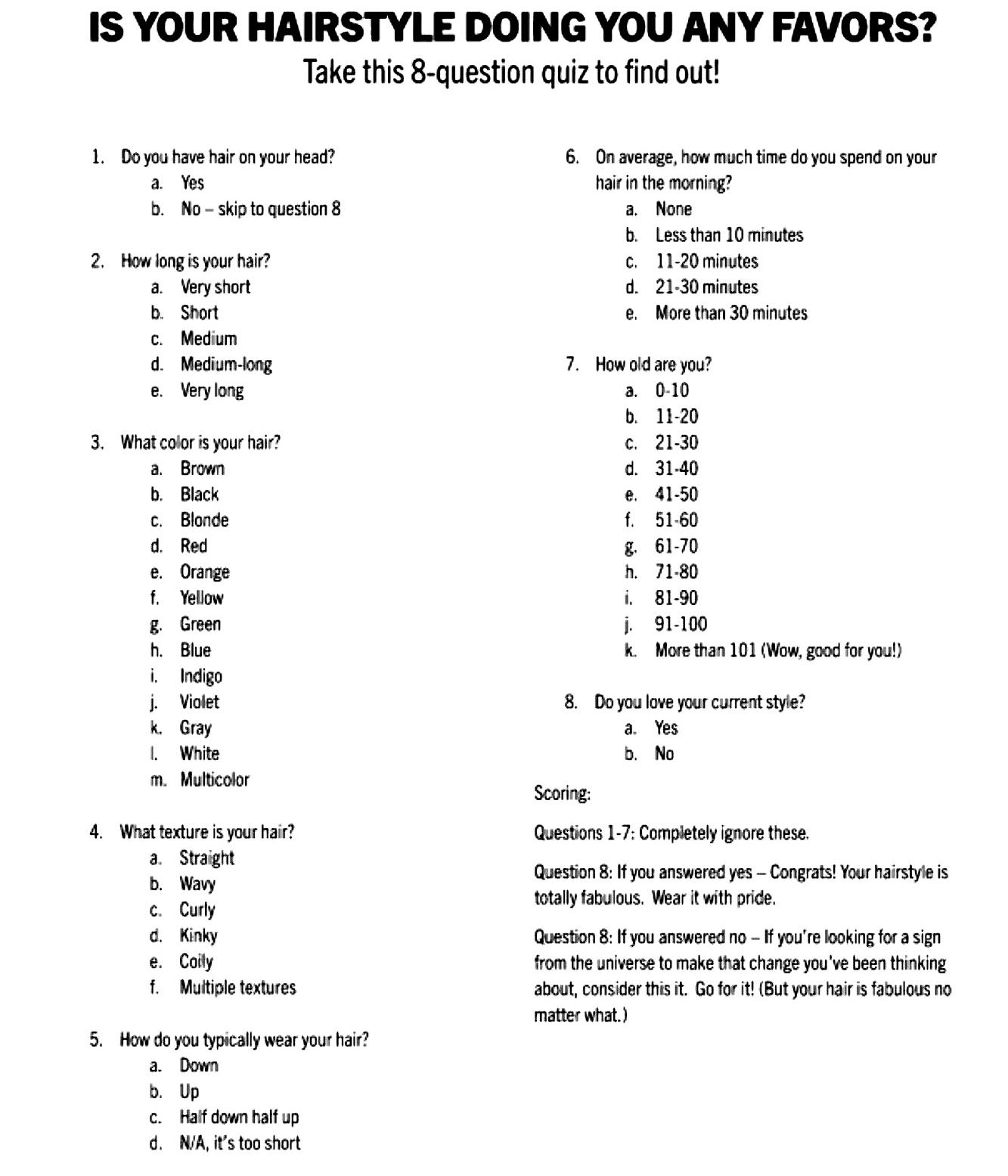


112 113
Editing:
Design:
Translations:
Mary Cason
Ellis Echevarria
Graciela Rivera


114 115




































 by Gary Gladstone
by Gary Gladstone





 Susan Bass
Susan Bass











 Jasmyne Pinkey, owner of BASWA Hair Cultivating Studio
Jasmyne Pinkey, owner of BASWA Hair Cultivating Studio

 Brigitte Reyes
Brigitte Reyes








































